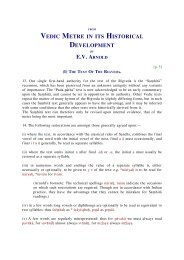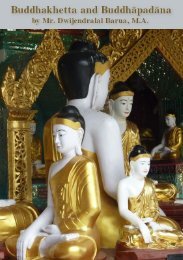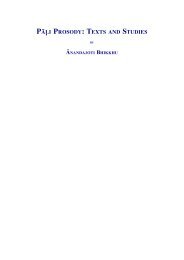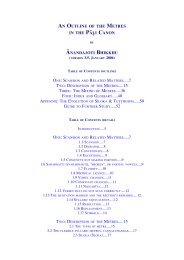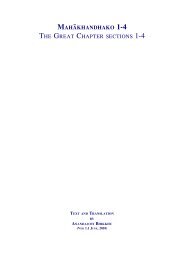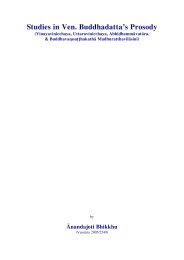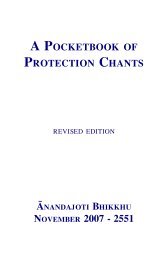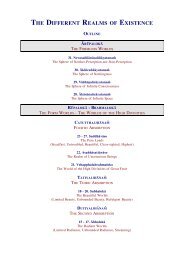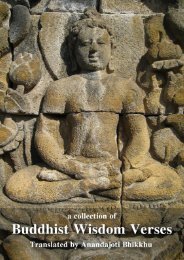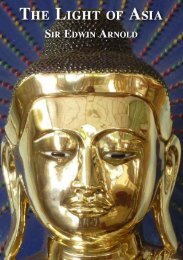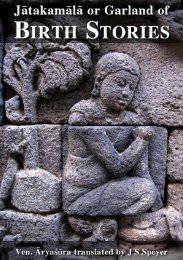Pubbakammapilotika-BuddhÄpadÄnaá¹ - buddhanet
Pubbakammapilotika-BuddhÄpadÄnaá¹ - buddhanet
Pubbakammapilotika-BuddhÄpadÄnaá¹ - buddhanet
You also want an ePaper? Increase the reach of your titles
YUMPU automatically turns print PDFs into web optimized ePapers that Google loves.
<strong>Pubbakammapilotika</strong>-Buddhāpadānaṁ<br />
Apadāna 39.10<br />
and their commentary in<br />
Visuddhajanavilāsiṇī<br />
Ānandajoti Bhikkhu<br />
(January, 2012, BE 2556)
Table of Contents<br />
Introduction.....3<br />
<strong>Pubbakammapilotika</strong>-Buddhāpadānaṁ.....9<br />
Buddha-Apadānavaṇṇanāto.....15<br />
[1. Dukkarakārikā].....15<br />
[2. Abbhakkhānaṁ].....16<br />
[3. Abbhakkhānaṁ].....21<br />
[4. Abbhakkhānaṁ].....22<br />
[5. Silāvedho].....23<br />
[6. Sakalikāvedho].....25<br />
[7. Nāḷāgiri].....26<br />
[8. Satthacchedo].....27<br />
[9. Sīsadukkhaṁ].....28<br />
[10. Yavakhādanaṁ].....28<br />
[11. Piṭṭhidukkhaṁ].....30<br />
[12. Atisāro].....31<br />
2
Introduction<br />
In preparing this text and translation for publication I have divided it into a number of<br />
versions. In the Buddhist Texts and Studies section will be found the Pāḷi Text together with<br />
the variant readings. This is a more technical work dealing with the establishment of the text,<br />
and considers the text from the point of view of its grammar and prosody, and gives a metrical<br />
analysis of the verses.<br />
In the Texts and Translations section I present the full Text and Translation with annotations<br />
which help to explain matters that may not be clear from the text itself. I have retained<br />
variants that give a significantly different reading in this edition, together with their<br />
translation, including verses and lines found only in one edition. The translation here follows<br />
the text quite closely to allow for reading and study of the latter.<br />
In the English section there is the Translation Only, with somewhat less notes than in the Text<br />
and Translations section, which is intended for the casual reader who wants a reliable<br />
translation but is not interested in the technical matters concerning the original text itself. Here<br />
the sentence structure, which has many sub-clauses and the like in the Pāḷi, has been simplified<br />
to present a more natural flow in English.<br />
Although the verses have been translated before, 1 this is the first time that the commentary has<br />
been brought over into English, and as far as I know the first time any section of the Apadāna<br />
commentary has been translated. 2<br />
1. Texts and Variations<br />
The texts presented have been established through a comparison of the four standard editions,<br />
for the verses from the Apadāna:<br />
BJT: Sri Lankan Edition, from Apadānapāḷi, Buddha Jayanti Tripiṭika Granthamālā, volume<br />
XXXVI. 1961, reprinted Colombo, 2005 with corrections.<br />
Thai: Thai edition, as found on Budsir for Windows CD-ROM (version 2.0, Bangkok, 1996).<br />
ChS: Burmese edition, as found on the Chaṭṭha Saṅgāyana CD-ROM (version 3, Igatpuri, no<br />
date, but = 1999).<br />
PTS: European edition, from The Apadāna, Part 1, edited by Mary E. Lilley, Pali Text<br />
Society, Oxford, 2000.<br />
and for the commentary:<br />
BJT: Sri Lankan Edition, from Visuddhajanavilāsiṇī, Part 1. Simon Hewavitarne Bequest<br />
Series, volume XXIX. date unknown.<br />
Thai: Thai edition, as found on Budsir for Windows CD-ROM (version 2.0, Bangkok, 1996).<br />
1 In Peter Masefield, The Udāna Commentary (PTS, 1994-5), pp. 633-635. Masefield also gives a<br />
summary of the commentarial stories in his notes, pp. 714-721.<br />
2 The material presented here has been discussed by Jonathon S. Walters, ‘The Buddha's Bad Kamma: A<br />
Problem in the History of Theravāda Buddhism’ Numen, 37/1 (1990); 70-95; Sally Mellick Cutler: ‘Still<br />
Suffering after All These Aeons,’ in Peter Connelly and Sue Hamilton (eds), Indian Insights: Buddhism,<br />
Brahmanism and Bhakti (London 1997); and more recently by Naomi Appleton, as part of her book<br />
Jātaka Stories in Theravāda Buddhism, pp. 27-28, (Farnham, 2010).<br />
3
Introduction<br />
ChS: Burmese edition, as found on the Chaṭṭha Saṅgāyana CD-ROM (version 3, Igatpuri, no<br />
date, but = 1999).<br />
PTS: European edition, from Visuddhajanavilāsiṇī nāma Apadānaṭṭhakathā, edited by C. E.<br />
Godakumbara, Pali Text Society, London, 1954.<br />
As the notes to the edition clearly show there is a close relationship between ChS and Thai on<br />
the one hand; and SHB and PTS on the other. Indeed in each case the latter text appears to be<br />
taking the former as its model and only correcting it occasionally.<br />
2. The Relationship between the Text and the Commentary<br />
The Apadāna is organised into four sections: Buddhāpadāna (81 3<br />
verses);<br />
Paccekabuddhāpadāna (58 verses); Therāpadāna (6311 verses, 559 Theras) and Therī-Apadāna<br />
(1336 verses, 40 Therīs). 4<br />
The texts which are translated here describe the previous deeds of the Buddha which led in his<br />
last life to various kinds of suffering: from spending a long time in the wasteland of severe<br />
austerities; to receiving slander at various hands; to physical ailments of various kinds: being<br />
attacked and cut by rocks and scalpels; and getting headaches, backaches and dysentry.<br />
We may have expected them to be presented therefore in the Traditions about the Buddha<br />
(Buddhāpadāna), which begins the book. Instead we find them tucked away in a very odd place:<br />
right in the middle of the verses which are otherwise concerned with the Elders, as No. 390 of<br />
that collection.<br />
Why they are there is hard to explain, and it almost looks like someone was trying to hide<br />
them. There is a very short commentary on the opening verses at that place, 5 but the main<br />
commentary occurs at the end of the Traditions about the Buddha (Buddhāpadānasaṁvaṇṇanā),<br />
which suggests that either the verses were once there, or the commentator wanted to draw<br />
attention to them.<br />
The commentary on these verses is curious as it is unlike other sections of the same work<br />
which only provide a word commentary (vaṇṇanā). Here though, we get the stories explaining<br />
the deeds the Buddha-to-be had performed in the past, 6 which were finding their fulfilment,<br />
even when he was Buddha.<br />
Also it should be mentioned that the commentary doesn't take the verses in the order they<br />
appear in the text, but has them in roughly chronological order. To give an example, although<br />
the text treats the austerities that the Buddha-to-be underwent last, in the commentary it is<br />
dealt with first. 7<br />
Another problem is that there is some confusion in the commentary to verse two, as the story<br />
doesn't fit in with the verse it is supposed to explain. 8 The story at the beginning is about a<br />
scoundrel called Munāḷi, who slandered the Independent Buddha Surabhi. The verse, however,<br />
says that the Buddha-to-be had accused a disciple of the Buddha Sabbābhibhu called Nanda,<br />
3<br />
Verse numbers are as in the Sri Lankan edition.<br />
4<br />
Note that the last section has no commentary on it.<br />
5<br />
Not translated here as it is basically a word-commentary (vaṇṇanā), and is seperated from the rest of<br />
the commentary.<br />
6<br />
As in, for instance, the Jātakaṭṭhakathā.<br />
7<br />
The commentary treats them in the order: 12, 2, 1, 3, 4, 5, 6, 7, 8, 9, 10, 11.<br />
8<br />
Masefield noted this in his comments to the verses in the Udāna Commentary.<br />
4
Introduction<br />
and it was for this reason that the maiden Ciñcā slandered him. On the other hand the story of<br />
Munāḷi is told again, but in different words, to explain the next verse, where it does fit in with<br />
what he is trying to explain.<br />
Another anomaly: the very next story tells of a time when the Bodhisatta was a teacher of five<br />
hundred students who slandered a seer. His students, following him, did the same. The verses,<br />
however, only mention that his disciples were slandered by Sundarī, and do not mention the<br />
Buddha's suffering.<br />
Again, story no. 6 says that the Buddha's foot was cut as a result of throwing a splinter at an<br />
Independent Buddha; the verses, however, tell about the time the Buddha was attacked by<br />
bandits or archers sent by Devadatta, who were overcome by the Buddha's loving-kindness, and<br />
failed though to cause him any harm. The time that his foot was cut was when Devadatta threw<br />
a rock from on high, as reported in story no. 5.<br />
It is worthy of notice that in the preface to his work, the unnamed commentator has this to say<br />
about the text he was working with:<br />
Purā Sīhaḷabhāsāya porāṇaṭṭhakathāya ca<br />
Setting aside the ancient commentary in the Sinhala language<br />
Ṭhapitaṁ taṁ na sādheti, sādhūnaṁ icchiticchitaṁ,<br />
Which does not make things clear, longing for what is profitable,<br />
Tasmā tam-upanissāya porāṇaṭṭhakathānayaṁ,<br />
Having forsaken reliance on that ancient commentary, therefore,<br />
Vivajjetvā viruddhatthaṁ, visesatthaṁ pakāsayaṁ,<br />
Which hinders (the true) meaning, (and) explaining the true meaning,<br />
Visesavaṇṇanaṁ seṭṭhaṁ karissāmatthavaṇṇanan-ti.<br />
I will make a true and good explanation, which explains the meaning (well).<br />
We know precious little about the commentator, not even his name, or who instigated his work,<br />
which is normally mentioned, but a couple of things seem to indicate that he was unfamiliar<br />
with northern India: he has the King of Magadha say that he would be present at the doublemiracle,<br />
but that event took place in another Kingdom, that of Kosala, and there is no<br />
indication that foreign Kings were present at the time; 9 he also says that Anuruddha and the<br />
other Sakyans were near to Rājagaha when they went forth, but in fact they were at Anupiya<br />
in the Malla country when that happened about 10 days, or 250 km, walk away.<br />
Given that he has declared his intention to put aside the Mahāvihāra commentary and write his<br />
own, which almost certainly would not have been possible if he had been resident there, this<br />
makes me believe that he was either from the Indian mainland, somewhere remote from the<br />
Middle Lands, perhaps in somewhere like Andhra; or that he was connected with another<br />
fraternity, perhaps the Abhayagiri; and there are other considerations which might help<br />
substantiate this.<br />
9 See commentarial story no. 2 below; and for the next instance story no. 5.<br />
5
Introduction<br />
3. Relationship with Other Traditions<br />
The compound used to describe the verses, kammapilotika (or in some editions kammapiloti)<br />
doesn't occur anywhere else in the Pāḷi texts except in connection with these verses; however, it<br />
does occur in Buddhist Sanskrit works 10 like Divyāvadāna, 11 Avadānaśataka and<br />
Laṅkāvatārasūtra; and there are parallels to the text in the Mūlasarvāstivāda<br />
Anavataptagāthā, 12 and in Gandhārī. 13<br />
What is more, one of the stories is told, in even more detail in the Mahāvastu. 14 In the verses<br />
here it only says that through slandering a disciple of the Buddha Sabbābhibhu called Nanda,<br />
the (unnamed) Buddha-to-be transmigrated through hell for a long time, and in his last<br />
existence was slandered in turn by the maiden Ciñcā; and as noted above the commentary<br />
doesn't provide an appropriate story here.<br />
The Mahāvastu, however, has a long story about a monk called Abhiya who, being of a jealous<br />
nature, slandered the disciple called Nanda accusing him of sexual relations with a wife of a<br />
rich merchant. The interesting conclusion has Abhiya realising his fault, asking forgiveness<br />
from Nanda, and confessing his wrong-doing to the Buddha. He then makes an offering to the<br />
Buddha and makes an aspiration to become a Buddha himself, which is confirmed by Buddha<br />
Sarvābhibhū.<br />
The idea of the connection of past deeds was also known to the Upāyakausalya also, 15 where it<br />
is said the Buddha only told these stories as part of his skill-in-means, but not because he<br />
actually ever did anything wrong, which the text categorically denies he could have done,<br />
which represents another view on the subject altogether.<br />
It is not within the scope of this introduction to examine all these continuities and<br />
discontinuities, but one thing is clear: the idea that the Buddha-to-be had done unwholesome<br />
deeds that came to fruition in the Buddha's lifetime was clearly known to the early traditions,<br />
even when it was rejected.<br />
4. The Bodhisatta's Bad Deeds<br />
That the Buddha-to-be should have done bad deeds should not surprise us, as it is recorded<br />
openly in the Jātaka stories that the Buddha-to-be many times did bad, unwholesome deeds. He<br />
is, of course, still pursuing the perfections, and has no claim to having completed them as yet,<br />
and so is bound to make misjudgements like everybody else.<br />
For instance, in Jā 128 the Buddha-to-be is reborn as a rat and springs at a jackal's throat and<br />
kills him; in Jā 318 he is born in a robber's family and practices his craft; in Jā 431 he engages<br />
in sexual misconduct with a queen – interestingly in the same Jātaka, though, it denies that the<br />
Buddha-to-be can tell lies:<br />
10 There the compounds are karmaplotika and karmaploti.<br />
11 Cf. Divyāvadāna p. 150, where one of the 10 indispensable deeds (daśāvaśyakaraṇīyāni) is listed as:<br />
Anavatapte mahāsarasi śrāvakaiḥ sārdhaṁ ; explaining the<br />
connection with former deeds with his disciples near the great lake Anavatapta (Anotatta in Pāḷi).<br />
12 See Bechert, Die Anavataptagāthā und die Sthaviragāthā, Berlin 1961.<br />
13 See http://gandhari.org/a_manuscript.php?catid=CKM0001.<br />
14 See Senart's edition: pg. 34-45. I hope to translate this text at some point.<br />
15 But there the compound is karmasantati, and the list is not twelve items, but ten. Most of them are the<br />
same as is recorded here, however, so that it is clear we are dealing with the same tradition.<br />
6
Introduction<br />
Bodhisattassa hi ekaccesu ṭhānesu pāṇātipāto pi adinnādānam-pi<br />
kāmesumicchācāro pi surāmerayamajjapānam-pi hoti yeva,<br />
atthabhedakavisaṁvādanaṁ 16 purakkhatvā, musāvādo nāma na hoti; the<br />
Buddha-to-be on certain occasions may kill, steal, engage in sexual misconduct and<br />
drink intoxicants; but he cannot, preferring to hurt the welfare (of others) by lying,<br />
speak falsely.<br />
and the reason for this is clearly stated:<br />
Ujjhitasaccā hi Bodhimūle nisīditvā, Bodhiṁ pāpuṇituṁ na sakkonti; even if<br />
one who has forsaken the truth has sat at the root of the Bodhi tree he is (still)<br />
unable to attain Awakening.<br />
This statement is questionable, though, as it appears he was lying when he slandered the<br />
Independent Buddha Surabhi, the disciple of the Buddha Sabbābhibhu named Nanda and the<br />
seer ( ṣi) Bhīma; and the repurcussion was that in turn he was slandered by Ciñcā and Sundarī.<br />
At another time he told the Buddha Phussa that he should eat barley, with the result that in his<br />
final life he had to do the same for three months during one Rains Retreat; he also questioned<br />
the possibility of the Buddha Kassapa being Awakened, and had to undergo six years of<br />
austerities on the wrong path.<br />
In previous lives as here recorded he also killed his half-brother, threw a stone at an<br />
Independent Buddha, and struck another with an elephant; for which he had to suffer his<br />
brother-in-law Devadatta throwing stones at him, hiring assassins and driving the elephant<br />
Nāḷāgiri at him.<br />
Because he laughed at some fish being killed he later got a headache (and the people who were<br />
doing the killing, being reborn in the Sakyan clan, were wiped out by King Viḍūḍabha); when<br />
he was a King he killed people with his sword, and because of that not only did a shard of<br />
stone cut his foot, but also the surgeon had to lance an abscess that developed on it; and<br />
when he was a wrestler he broke an opponents back, 17 and therefore had to suffer<br />
backache.<br />
Each time he is said to have suffered greatly for a long time in various hells, and it is really<br />
only the residue of the deeds that came to fruition causing these problems for the Buddha in<br />
his last life.<br />
Although the Buddha-to-be is said to have committed all these unwholesome acts, they are, of<br />
course, presented as examples of what not to do, as the repurcussions are so dire, that even<br />
upon the attainment of Buddhahood they cannot be escaped, so that in the end the moral is<br />
clear. Towards the end of the commentary it is indeed stated emphatically:<br />
16 This is translated by Francis and Neill (Jā trans. Vol III, pg. 296): he may not tell a lie, attended by<br />
deception that violates the reality of things; although it has a wide range of meanings I do not find<br />
anywhere where attha means the reality of things; its primary meaning is (PED, s.v.): interest,<br />
advantage, gain; (moral) good, blessing, welfare; profit, prosperity, well-being.<br />
17 Though according to the commentary he fixed it again soon after, see story no 11 below.<br />
7
Introduction<br />
Kammapilotikaṁ nāma Buddham-api na muñcati. 18<br />
The Buddha was surely not free from the connection with that deed.<br />
Kammapilotikaṁ evarūpaṁ Lokattayasāmim-pi na vijahati.<br />
The Lord of the Three Worlds surely could not abandon the connection with that deed.<br />
And the moral is, of course, that neither can we, so we had better be careful about the deeds<br />
we choose to perform.<br />
Ānandajoti Bhikkhu<br />
January 2012<br />
18 Just before the verses in story No 11 below; the next quote appears before the verses in story No 12.<br />
8
<strong>Pubbakammapilotika</strong>-Buddhāpadānaṁ 19<br />
⏑−−⏑¦⏑−−−¦¦⏑⏑−−¦⏑−⏑− pathyā 20<br />
Anotattasarāsanne, 21 ramaṇīye silātale,<br />
−−⏑⏑¦⏑−−−¦¦−−−⏑¦⏑−⏑−<br />
Nānāratanapajjote, nānāgandhavanantare, [64]<br />
⏑⏑−−¦⏑−−−¦¦⏑−−−¦⏑−⏑−<br />
Mahatā bhikkhusaṅghena, pareto Lokanāyako,<br />
−−−−¦⏑−−−¦¦−⏑−−¦⏑−⏑−<br />
Āsīno byākarī 22 tattha pubbakammāni attano: [65]<br />
⏑−⏑−¦⏑−−−¦¦−−−⏑¦⏑−⏑−<br />
Suṇātha 23 bhikkhavo 24 mayhaṁ 25 yaṁ kammaṁ pakataṁ 26 mayā, 27<br />
⏑−⏑−¦⏑−−−¦¦−−−⏑¦⏑−⏑−<br />
Pilotikassa 28 kammassa Buddhatte 29 pi vipaccati. 30 [66]<br />
⏑−⏑−¦⏑−−−¦¦−−−−¦⏑−⏑−<br />
Munāḷi 31 nāmahaṁ dhutto pubbe aññāsu jātisu,<br />
−−⏑−¦−⏑⏑−¦¦−−−−¦⏑−⏑− bhavipulā<br />
Paccekabuddhaṁ Surabhiṁ abbhācikkhiṁ adūsakaṁ; [67]<br />
−⏑−⏑¦⏑−−−¦¦⏑⏑−−¦⏑−⏑−<br />
Tena kammavipākena Niraye saṁsariṁ ciraṁ,<br />
⏑−−⏑¦⏑−−−¦¦−−−−¦⏑−⏑−<br />
Bahūvassasahassāni, dukkhaṁ vedesi' 32 vedanaṁ. [68]<br />
[1]<br />
−⏑−−¦⏑−−−¦¦⏑⏑−⏑¦⏑−⏑−<br />
Tena kammāvasesena, idha pacchimake bhave,<br />
19 BJT: Pubbakammapilotikāpadānaṁ; PTS: Pubbakammapiloti; Thai: Dasamaṁ Pubbakammapiloti nāma<br />
Buddhāpadānaṁ.<br />
20 All the lines are Siloka, and should be presumed to be pathyā unless otherwise marked.<br />
21 The text is reproduced word for word in the Udānaṭṭhakathā, being quoted from here.<br />
22 BJT, PTS: vy-, and similarly throughout; orthographical variant only; Thai byākari.<br />
23 PTS: suṇotha; alternative form.<br />
24 Thai: bhikkhave; a different form of the vocative.<br />
25 PTS: mayham, by mistake.<br />
26 PTS: pakatam; variation in sandhi.<br />
27 Thai adds the following verse: Ekaṁ araññikaṁ bhikkhuṁ disvā dinnaṁ pilotikaṁ, patthitaṁ paṭhamaṁ<br />
Buddhaṁ Buddhattāya mayā tadā; Having seen one forest monk, I gave a rag-robe, the first wish for<br />
Buddhahood, was then (made) by me. Lines c & d hardly make sense in the Pāḷi, and I have omitted<br />
Buddhaṁ in the translation and added a word for made, perhaps we should read: patthitaṁ paṭhamaṁ<br />
kataṁ; which would give a Anuṭṭhubha variation.<br />
28 Thai, PTS: pilotiyassa; showing the k/y vriation found in the texts.<br />
29 PTS: Buddhatthe; PTS seems to waver between Buddhatta and Buddhattha, it seems the former is<br />
correct.<br />
30 Thai adds these two verses: Gopālako pure āsiṁ gāviṁ pājeti gocaraṁ, Pivantiṁ udakaṁ āvilaṁ gāviṁ<br />
disvā nivārayiṁ; tena kammavipākena idha pacchimake bhave pipāsito yathicchakaṁ na hi pātuṁ<br />
labhāmahaṁ; before when I was a cow-herder I drove cows to their pasture, having seen a cow drink<br />
from clear water I prevented him; through that deed and its result here in my last existence (when)<br />
thirsty and desiring the same I did not get (anything) to drink.<br />
31 PTS: Munāli; and so throughout; common l/ḷ variation; Thai: Punāli.<br />
32 SHB, PTS: vedesiṁ; against the metre.<br />
9
<strong>Pubbakammapilotika</strong>-Buddhāpadānaṁ<br />
−−−−¦⏑−−−¦¦−⏑⏑−¦⏑−⏑−<br />
Abbhakkhānaṁ mayā laddhaṁ, Sundarikāya 33 kāraṇā. [69]<br />
−−⏑−¦⏑−−−¦¦−−−−¦⏑−⏑−<br />
Sabbābhibhussa Buddhassa Nando nāmāsi sāvako,<br />
−−−−¦⏑⏑⏑−¦¦⏑−−⏑¦⏑−⏑− navipulā<br />
Taṁ abbhakkhāya 34 Niraye ciraṁ saṁsaritaṁ mayā, [70]<br />
⏑⏑−⏑¦⏑−−−¦¦⏑⏑−−¦⏑−⏑−<br />
Dasavassasahassāni Niraye saṁsariṁ ciraṁ,<br />
⏑−⏑−¦−,−−−¦¦−−−−¦⏑−⏑− mavipulā<br />
Manussabhāvaṁ 35 laddhāhaṁ, abbhakkhānaṁ bahuṁ labhiṁ, [71]<br />
[2]<br />
−⏑−−¦⏑−−−¦¦−⏑−⏑¦⏑−⏑−<br />
Tena kammāvasesena Ciñcamānavikā mamaṁ<br />
−−−⏑¦⏑−−−¦¦⏑⏑−−¦⏑−⏑−<br />
Abbhācikkhi 36 abhūtena janakāyassa aggato. 37 [72]<br />
[3]<br />
−⏑−⏑¦⏑−−−¦¦⏑−−⏑¦⏑−⏑−<br />
Brāhmaṇo Sutavā āsiṁ ahaṁ sakkatapūjito,<br />
⏑−⏑−¦−⏑⏑−¦¦−−−−¦⏑−⏑− bhavipulā<br />
Mahāvane pañcasate mante vācesi 38 māṇave. [73]<br />
−−⏑−¦⏑−−−¦¦−−−−¦⏑−⏑−<br />
Tatthāgato isī 39 Bhīmo, 40 pañcābhiñño 41 mahiddhiko,<br />
−−−−¦⏑−−−¦¦−−−−¦⏑−⏑−<br />
Taṁ cāhaṁ 42 āgataṁ disvā, abbhācikkhiṁ 43 adūsakaṁ, [74]<br />
⏑−−⏑¦⏑−−−¦¦−⏑−−¦⏑−⏑−<br />
Tatohaṁ avacaṁ sisse: ‘Kāmabhogī ayaṁ isi’.<br />
−−⏑−¦⏑−−−¦¦⏑⏑−−¦⏑−⏑−<br />
Mayham-pi bhāsamānassa 44 anumodiṁsu māṇavā. [75]<br />
⏑−−⏑¦⏑−−−¦¦−⏑−−¦⏑−⏑−<br />
Tato māṇavakā sabbe bhikkhamānaṁ 45 kulākule, 46<br />
33 PTS: Sundarīkāya; perhaps to correct the metre, but it seems from these verses that light syllables were<br />
allowed in 2nd and 3rd places, as they occur without any variations twice below also.<br />
34 Thai: abbhācikkhāya; against the metre.<br />
35 Thai: Manussalābhaṁ; which hardly makes sense.<br />
36 BJT, PTS: abbhākkhāsi; same meaning.<br />
37 Thai: aggatā?<br />
38 All texts are against this reading, but comm. is for it, and it fits better to have an aorist here, rather<br />
than a present tense.<br />
39 SHB, PTS, ChS: isi, but savipulā is very rare in late texts, and pathyā is to be preferred.<br />
40 PTS: Isigaṇo, this seems to be taken it as a proper name.<br />
41 PTS: pañcābhiññā-, in compound with the next word.<br />
42 BJT: Tañ-cāham; alternative sandhi.<br />
43 BJT: abbhācikkhim-; alternative sandhi.<br />
44 PTS: Mayhaṁ vibhāsamānassa; no proper meaning.<br />
45 Thai, PTS: bhikkhamānā, plural form with sabbe, which takes either singular or plural.<br />
46 BJT, ChS, Thai: kule kule; in family after family.<br />
10
<strong>Pubbakammapilotika</strong>-Buddhāpadānaṁ<br />
⏑−⏑−¦⏑−−−¦¦−⏑−−¦⏑−⏑−<br />
Mahājanassa āhaṁsu: 47 ‘Kāmabhogī ayaṁ isi’; [76]<br />
−⏑−⏑¦⏑−−−¦¦−⏑−⏑¦⏑−⏑−<br />
Tena kammavipākena pañcabhikkhusatā ime<br />
−−−−¦⏑−−−¦¦−⏑⏑−¦⏑−⏑−<br />
Abbhakkhānaṁ labhuṁ sabbe Sundarikāya kāraṇā. [77]<br />
−−⏑−¦⏑−−−¦¦⏑⏑−⏑¦⏑−⏑−<br />
Vemātubhātaraṁ 48 pubbe dhanahetu haniṁ ahaṁ,<br />
−⏑−⏑¦⏑−−−¦¦⏑−⏑⏑¦⏑−⏑−<br />
Pakkhipiṁ giriduggasmiṁ, 49 silāya ca apiṁsayiṁ, [78]<br />
[4]<br />
−⏑−⏑¦⏑−−−¦¦−⏑−−¦⏑−⏑−<br />
Tena kammavipākena Devadatto silaṁ khipi,<br />
−−−−¦⏑−−−¦¦⏑⏑−−¦⏑−⏑−<br />
Aṅguṭṭhaṁ piṁsayī pāde mama pāsāṇasakkharā. [79]<br />
⏑−−−¦⏑−−−¦¦−⏑−−¦⏑−⏑−<br />
Purehaṁ dārako hutvā, kīḷamāno mahāpathe,<br />
−−⏑−¦−,−−−¦¦−−⏑⏑¦⏑−⏑− mavipulā<br />
Paccekabuddhaṁ disvāna magge sakalikaṁ khipiṁ; 50 [80]<br />
−⏑−⏑¦⏑−−−¦¦⏑⏑−⏑¦⏑−⏑−<br />
Tena kammavipākena idha pacchimake bhave<br />
⏑−−−¦−⏑−−¦¦⏑⏑−−¦⏑−⏑− ravipulā<br />
Vadhatthaṁ maṁ Devadatto abhimāre 51 payojayi. [81]<br />
[5]<br />
[6]<br />
−−−−¦⏑−−−¦¦−−⏑⏑¦⏑−⏑−<br />
Hatthāroho pure āsiṁ, Paccekamunim-uttamaṁ,<br />
−−⏑⏑¦⏑−−−¦¦−−−−¦⏑−⏑−<br />
Piṇḍāya vicarantaṁ taṁ, 52 āsādesiṁ gajenahaṁ; [82]<br />
−⏑−⏑¦⏑−−−¦¦−−−−¦⏑−⏑−<br />
Tena kammavipākena bhanto Nāḷāgirī gajo<br />
⏑−⏑−¦⏑⏑⏑−¦¦−⏑−−¦⏑−⏑− navipulā<br />
Giribbaje puravare dāruṇo maṁ upāgami. 53 [83]<br />
47 PTS: ahaṁsu, the correct form appears to be as in the text.<br />
48 PTS: Dvemātā-bhātaro; brothers of two mothers (and same father).<br />
49 PTS: giriduggesu; another form of the locative; Thai: gariduggesu?<br />
50 Thai, PTS: dahiṁ; perhaps placed, which doesn't give a good meaning.<br />
51 Thai: atimāre; I cannot find this word in the dictionaries.<br />
52 Thai: vicarantaṁ pi.<br />
53 ChS, Thai: samupāgami.<br />
11
<strong>Pubbakammapilotika</strong>-Buddhāpadānaṁ<br />
[7]<br />
−−−−¦⏑−−−¦¦−⏑−⏑¦⏑−⏑−<br />
Rājāhaṁ pattiko 54 āsiṁ sattiyā 55 purise 56 haniṁ;<br />
−⏑−⏑¦⏑−−−¦¦⏑⏑−−¦⏑−⏑−<br />
Tena kammavipākena Niraye paccisiṁ 57 bhusaṁ, [84]<br />
−⏑−−¦⏑−−−¦¦⏑−⏑⏑¦⏑−⏑−<br />
Kammuno 58 tassa sesena, idāni 59 sakalaṁ mama<br />
−−⏑−¦⏑−−−¦¦⏑⏑−−¦⏑−⏑−<br />
Pāde chaviṁ pakappesi, 60 na hi kammaṁ vinassati. 61 [85]<br />
⏑−−−¦⏑−−−¦¦⏑−−−¦⏑−⏑−<br />
Ahaṁ kevaṭṭagāmasmiṁ ahuṁ 62 kevaṭṭadārako<br />
−⏑−−¦⏑−−−¦¦⏑⏑−−¦⏑−⏑−<br />
Macchake ghātite 63 disvā janayiṁ somanassakaṁ; [86]<br />
−⏑−⏑¦⏑−−−¦¦−⏑−−¦⏑−⏑−<br />
Tena kammavipākena sīsadukkhaṁ 64 ahū mama,<br />
−−−−¦⏑−−−¦¦⏑−⏑⏑¦⏑−⏑−<br />
Sabbe Sakkā ca haññiṁsu 65 yadā hani Viḍūḍabho. 66 [87]<br />
−−−−¦−⏑⏑−¦¦−⏑−⏑¦⏑−⏑− bhavipulā<br />
Phussassāhaṁ pāvacane sāvake paribhāsayiṁ:<br />
⏑−−⏑¦⏑−⏑−¦¦−⏑−⏑¦⏑−⏑− Anuṭṭubha<br />
“Yavaṁ khādatha bhuñjatha, mā ca bhuñjatha sālayo”; 67 [88]<br />
−⏑−⏑¦⏑−−−¦¦−−−−¦⏑−⏑−<br />
Tena kammavipākena temāsaṁ khāditaṁ yavaṁ<br />
⏑−⏑−¦−⏑−−¦¦−−−−¦⏑−⏑− ravipulā<br />
Nimantito brāhmaṇena Verañjāyaṁ 68 vasiṁ tadā. [89]<br />
[8]<br />
[9]<br />
54<br />
BJT, PTS, ChS: patthivo; which means king, as does Rāja, in PTS (at least) it is not used as a proper<br />
name, as one might have expected, and therefore makes little sense.<br />
55<br />
BJT: sattinā; taking it as a masculine noun.<br />
56<br />
BJT, PTS: purisaṁ; a man, singular.<br />
57<br />
Thai, BJT, ChS: paccisaṁ, unexpected form.<br />
58<br />
PTS: kammuṇo; unexpected form.<br />
59<br />
Thai: so dāni.<br />
60<br />
PTS: c'ādiṇṇaṁ sakalaṁ mama pāde chaviṁ pakopesi; he angrily cut the skin on my entire foot; BJT<br />
also reads: pakopesi, but then omits a word for cutting, which would seem to be required.<br />
61<br />
PTS: panassati; (deeds) are not lost.<br />
62<br />
Thai: ahu.<br />
63<br />
Thai: Macchopaghātite; implying a verb upaghāteti, which is otherwise not found.<br />
64<br />
PTS: dukkham-; alternative sandhi.<br />
65<br />
Thai, PTS: Sakkesu haññamānesu; taking it as a locative absolutive construction?<br />
66<br />
PTS: Viḍuḍabho; ChS: Viṭaṭūbho; Thai: Viṭaṭubho; and similarly throughout. The correct form of the<br />
name, which is said to have formed through a confusion anyway, is lost now.<br />
67<br />
Thai, PTS: sāliyo; taking the word as a feminine.<br />
68<br />
PTS: Verajjāyaṁ; showing the ñj/jj alternation.<br />
12
<strong>Pubbakammapilotika</strong>-Buddhāpadānaṁ<br />
[10]<br />
−−−−¦⏑−−−¦¦−⏑−−¦⏑−⏑−<br />
Nibbuddhe vattamānamhi mallaputtaṁ niheṭhayiṁ; 69<br />
−⏑−⏑¦⏑−−−¦¦−⏑−−¦⏑−⏑−<br />
Tena kammavipākena piṭṭhidukkhaṁ ahū 70 mama. 71 [90]<br />
[11]<br />
⏑−⏑−¦⏑−−−¦¦−⏑−−¦⏑−⏑−<br />
Tikicchako ahaṁ āsiṁ seṭṭhiputtaṁ virecayiṁ;<br />
−⏑−⏑¦⏑−−−¦¦−⏑−−¦⏑−⏑−<br />
Tena kammavipākena hoti pakkhandikaṁ 72 mama. [91]<br />
[12]<br />
⏑⏑−−¦−⏑−−¦¦⏑⏑−−¦⏑−⏑− ravipulā<br />
Avacāhaṁ Jotipālo Sugataṁ Kassapaṁ tadā:<br />
⏑−⏑−¦⏑−−−¦¦−⏑⏑⏑¦⏑−⏑−<br />
“Kuto nu Bodhi muṇḍassa? 73 Bodhi paramadullabhā!” [92]<br />
−⏑−⏑¦⏑−−−¦¦⏑⏑−−¦⏑−⏑−<br />
Tena kammavipākena acariṁ dukkaraṁ bahuṁ,<br />
−−−⏑¦⏑−−−¦¦⏑−−⏑¦⏑−⏑−<br />
Chabbassān-Uruvelāyaṁ 74 tato Bodhim-apāpuṇiṁ. [93]<br />
−−−−¦⏑−−−¦¦−⏑−−¦⏑−⏑−<br />
Nāhaṁ etena maggena pāpuṇiṁ Bodhim-uttamaṁ,<br />
−−−⏑¦⏑−−−¦¦−⏑−−¦⏑−⏑−<br />
Kummaggena gavesissaṁ pubbakammena vārito. 75 [94]<br />
−⏑−⏑¦⏑−−−¦¦−⏑−−¦⏑−⏑−<br />
Puññapāpaparikkhīṇo, 76 sabbasantāpavajjito,<br />
⏑−−⏑¦⏑−−−¦¦−−−⏑¦⏑−⏑−<br />
Asoko anupāyāso, nibbāyissam-anāsavo. [95]<br />
−−⏑−¦⏑−−−¦¦−⏑−−¦⏑−⏑−<br />
Evaṁ Jino viyākāsi bhikkhusaṅghassa aggato, 77<br />
−−−−¦⏑−−−¦¦⏑−−−¦⏑−⏑−<br />
Sabbābhiññābalappatto, Anotatte mahāsare.” ti 78 [96]<br />
69 Thai, PTS: nisedhayiṁ; I fought off.<br />
70 Thai, PTS: ahu, against the metre.<br />
71 BJT: mamaṁ ahu.<br />
72 BJT, ChS, PTS: pakkhandikā; nominative.<br />
73 Thai: Bodhimaṇḍassa?<br />
74 BJT, ChS, PTS: Uruveḷāyaṁ; showing the common l/ḷ variation.<br />
75 PTS: kārito; the form is causative, and doesn't really fit here; Thai: codito; reproved (by that past deed)?<br />
76 PTS: -khīṇo; where we would expect gemination.<br />
77 Thai: atthato?<br />
78 BJT omits ti.<br />
13
<strong>Pubbakammapilotika</strong>-Buddhāpadānaṁ<br />
Itthaṁ sudaṁ Bhagavā attano pubbacaritaṁ pubbakammapilotikaṁ 79 nāma Buddhāpadānaṁ 80<br />
Dhammapariyāyaṁ abhāsittha. 81<br />
<strong>Pubbakammapilotika</strong>ṁ 82 nāma Buddhāpadānaṁ Samattaṁ 83<br />
79<br />
ChS omits pubba-; PTS: pubbakammapiloti; Thai: pubbakammapilotiṁ.<br />
80<br />
BJT omits Buddhāpadānaṁ; ChS: Buddhāpadānadhammapariyāyaṁ; sandhi form.<br />
81<br />
SHB, PTS: abhāsi; aorist, abhāsittha appears to be an imperfect.<br />
82<br />
Thai, PTS: Pubbakammapiloti.<br />
83<br />
SHB, ChS: Dasamaṁ; the Tenth.<br />
14
<strong>Pubbakammapilotika</strong>-Buddhāpadānaṁ<br />
Buddha-Apadānavaṇṇanāto<br />
... Buddhāpadānaṁ kusalāpadānavasena niṭṭhāpetvā, tad-eva akusalāpadānavasena vitthāretuṁ<br />
idaṁ pañhakammaṁ.<br />
Dukkarañ-ca abbhakkhānaṁ, abbhakkhānaṁ punāparaṁ,<br />
Abbhakkhānaṁ, silāvedho, sakalikāpi ca vedanā.<br />
Nāḷāgiri, 84 sattacchedo, 85 sīsadukkhaṁ, yavakhādanaṁ,<br />
Piṭṭhidukkham-atīsāro, 86 ime akusalakāraṇā. ti<br />
[1. Dukkarakārikā]<br />
Tattha, 87 paṭhamapañhe dukkaran-ti, chabbassāni dukkarakārikā.<br />
Atīte Kassapasammāsambuddhakāle, Bodhisatto Jotipālo nāma brāhmaṇamāṇavo hutvā,<br />
nibbatto brāhmaṇajātivasena Sāsane appasanno tassa Bhagavato, pilotikakammanissandena:<br />
“Kassapo Bhagavā” ti sutvā, “Kuto muṇḍakassa samaṇassa Bodhi? Bodhi paramadullabhā” ti<br />
āha.<br />
So tena kammanissandena anekajātisatesu Narakādīsu 88 dukkham-anubhavitvā, 89 tasseva 90<br />
Bhagavato anantaraṁ teneva 91 laddhabyākaraṇena, 92 kammena jātisaṁsāraṁ khepetvā,<br />
pariyosāne Vessantarattabhāvaṁ patvā, tato cuto Tusitabhavane nibbatto.<br />
Devatāyācanena tato cavitvā, Sakyakule nibbatto, ñāṇassa paripākattā, sakala-Jambudīparajjaṁ<br />
pahāya, Anomānadītīre sunisitenāsinā samakūṭakesakalāpaṁ 93 chinditvā, Brahmunā ānīte<br />
iddhimaye kappassa saṇṭhānakāle, 94 padumagabbhe nibbatte aṭṭhaparikkhāre paṭiggahetvā<br />
pabbajitvā, Bodhiñāṇadassanassa tāva aparipakkattā, Buddhabhāvāya maggāmaggaṁ ajānitvā,<br />
chabbassāni Uruvelajanapade ekāhāra-ekālopa-ekapuggala-ekamagga- 95 ekāsanabhojanavasena<br />
aṭṭhicammanahārusesaṁ nimmaṁsarudhirapetarūpasadisasarīro, 96 Mahāpadhānasutte 97<br />
vuttanayeneva padhānaṁ, mahāviriyaṁ 98 dukkarakārikaṁ akāsi.<br />
84 SHB: Nālāgiri; and so throughout, showing the l/ḷ alternation in the texts.<br />
85 PTS: sattha-; (cut with) a knife.<br />
86 -ī- is m.c. to give pathyā cadence.<br />
87 ChS: Atha; Then.<br />
88 SHB omits: Narakādīsu.<br />
89 ChS, Thai: Narakādi-; in compound, but compare elsewhere.<br />
90 SHB: tasmeva; therefore.<br />
91 PTS: anantariten' eva?<br />
92 PTS, SHB: vyā-, PTS, SHB always write with the v before y; this seems to be an orthographical<br />
variation in the texts. SHB has a different construct: Bhagavatā laddhavyākaraṇo anantaraṁ teneva;<br />
which gives the same meaning.<br />
93 Thai, PTS: -kuṭa-; a variation in the spelling of the word.<br />
94 PTS: kappasaṇṭhānakāle; same words in compound.<br />
95 PTS adds -ekataṇḍula-; one rice-grain; SHB omits ekamagga.<br />
96 PTS has these two words in compound.<br />
97 DN 14, which hardly touches on the subject of the striving, but with the process of Awakening; ChS,<br />
Thai: Padhānasutte, and identifies it with Suttanipāta, 3.2, but that also deals not so much with the<br />
striving as with the fight with Māra. Perhaps a better reference would have been to MN 26,<br />
Ariyapariyesanasuttaṁ, which does deal in detail with the striving.<br />
98 ChS, Thai: -vīriyaṁ; Thai and ChS always spell the word this way.<br />
15
<strong>Pubbakammapilotika</strong>-Buddhāpadānaṁ<br />
So imaṁ dukkarakārikaṁ Sambodhiyā maggaṁ na hotī ti cintetvā, gāmanigamarājadhānīsu<br />
paṇītāhāraṁ paribhuñjitvā, pīṇitindriyo 99 paripuṇṇadvattiṁsa-Mahāpurisalakkhaṇo, kamena 100<br />
Bodhimaṇḍam-upagantvā pañca Māre jinitvā Buddho jāto. ti<br />
Avacāhaṁ Jotipālo Sugataṁ Kassapaṁ 101 tadā:<br />
“Kuto nu Bodhi muṇḍassa? Bodhi paramadullabhā!” [92]<br />
Tena kammavipākena acariṁ dukkaraṁ bahuṁ,<br />
Chabbassān-Uruvelāyaṁ 102 tato Bodhim-apāpuṇiṁ. [93]<br />
Nāhaṁ 103 etena maggena pāpuṇiṁ Bodhim-uttamaṁ,<br />
Kummaggena gavesissaṁ 104 pubbakammena vārito. 105 [94]<br />
Puññapāpaparikkhīṇo, sabbasantāpavajjito,<br />
Asoko anupāyāso, nibbāyissam-anāsavo. ti [95]<br />
[2. Abbhakkhānaṁ]<br />
Dutiyapañhe, abbhakkhānan-ti abhi akkhānaṁ paribhāsanaṁ.<br />
Atīte kira Bodhisatto suddakule jāto apākaṭo appasiddho Munāḷi 106 nāma dhutto hutvā<br />
paṭivasati. Tadā mahiddhiko mahānubhāvo Surabhi nāma Paccekabuddho, kenaci karaṇīyena<br />
tassa samīpaṭṭhānaṁ pāpuṇi. So taṁ disvā va: “Dussīlo pāpadhammo ayaṁ samaṇo!” ti-ādinā 107<br />
abbhācikkhi.<br />
So tena akusalanissandena Narakādīsu 108 anekavassasahassāni dukkham-anubhavitvā, imasmiṁ<br />
pacchimattabhāve, yadā titthiyā paṭhamataraṁ – Bhagavato Tusitabhavane vasanasamaye va 109<br />
– pākaṭā hutvā, sakalajanaṁ 110 vañcetvā dvāsaṭṭhidiṭṭhiyo dīpetvā vicariṁsu. 111<br />
Tadā Tusitapurā cavitvā, Sakyarājakule 112 nibbattitvā kamena Buddho jāto. Titthiyā<br />
sūriyuggamane khajjopanakā viya vihatalābhasakkārā Bhagavati āghātaṁ bandhitvā vicaranti.<br />
99 SHB, ChS, Thai: pīṇindriyo.<br />
100 SHB: tam-enaṁ; it would mean: the same (person).<br />
101 SHB, PTS: Kassapaṁ Sugataṁ.<br />
102 SHB: Chabbassam-Uruvelāya; alternative forms; ChS, Thai, PTS: Uruveḷayaṁ; note the l/ḷ alternation<br />
again.<br />
103 SHB, PTS: So 'haṁ; which reverses the meaning.<br />
104 SHB, PTS write: kummagge na gavesissaṁ; which again reverses the meaning.<br />
105 SHB, PTS: kārito; giving a meaning for the verse: I attained the supreme wisdom through this path, I<br />
did not seek along the wrong path because I was a maker of past deeds? I do not understand this choice<br />
of readings.<br />
106 SHB: Munāli; throughout.<br />
107 SHB: ty-ādinā; applying sandhi rules.<br />
108 SHB again omits: Narakādīsu.<br />
109 ChS, Thai: ca.<br />
110 SHB: sakajanaṁ: their own people? Or perhaps a printer's error for: sakalajanaṁ.<br />
111 ChS, Thai, PTS: vicaranti; present tense.<br />
112 SHB: Sakka-; alternative form.<br />
16
<strong>Pubbakammapilotika</strong>-Buddhāpadānaṁ<br />
Tasmiṁ samaye Rājagahaseṭṭhi 113 Gaṅgāya, jālaṁ bandhitvā, kīḷanto rattacandanaghaṭikaṁ 114<br />
disvā “Amhākaṁ gehe candanāni bahūni,” imaṁ bhamaṁ āropetvā, tena 115 bhamakārehi<br />
pattaṁ likhāpetvā, veḷuparamparāya laggetvā, “Ye imaṁ pattaṁ iddhiyā āgantvā gaṇhanti<br />
tesaṁ bhattiko 116 bhavissāmī” ti bheriṁ carāpesi.<br />
Tadā titthiyā: “Naṭṭhamhā dāni, naṭṭhamhā dānī!” ti mantesuṁ, 117 nigaṇṭho Nāṭaputto 118<br />
sakaparisaṁ evam-āha: “Ahaṁ veḷusamīpaṁ gantvā, ākāse ullaṅganākāraṁ karomi,<br />
tumhe: ‘Chavadārumayaṁ pattaṁ paṭicca mā iddhiṁ karothā’ ti maṁ khandhe gahetvā<br />
vārethā” ti, te tattha 119 gantvā tathā akaṁsu.<br />
Tadā Piṇḍolabhāradvājo ca 120 Moggallāno ca, tigāvute selapabbatamatthake ṭhatvā,<br />
piṇḍapātagaṇhanatthāya 121 cīvaraṁ pārupantā, taṁ kolāhalaṁ suṇiṁsu. Tesu Moggallāno<br />
Piṇḍolabhāradvājaṁ: “Tvaṁ ākāsena gantvā, taṁ pattaṁ gaṇhāhī” ti āha. So: “Bhante, tumhe<br />
yeva Bhagavatā iddhimantānaṁ aggaṭṭhāne ṭhapitā, tumheva gaṇhathā” ti āha.<br />
Tathā pi: “Mayā āṇatto 122 tvam-eva gaṇhāhī” ti āṇatto, attanā ṭhitaṁ, tigāvutaṁ selapabbataṁ<br />
pādatale laggetvā, ukkhaliyā pidhānaṁ viya sakala-Rājagahanagaraṁ chādesi, tadā<br />
nagaravāsino phaḷikapabbate āvutaṁ rattasuttam-iva taṁ Theraṁ passitvā, “Bhante Bhāradvāja,<br />
amhe rakkhathā!” ti ugghosayiṁsu, 123 bhītā suppādīni sīse akaṁsu.<br />
Tadā Thero, taṁ pabbataṁ ṭhitaṭṭhāne vissajjetvā, iddhiyā gantvā, taṁ pattaṁ aggahesi, tadā<br />
nagaravāsino mahākolāhalam-akaṁsu.<br />
Bhagavā Veḷuvanārāme nisinno, taṁ saddaṁ sutvā, “Kiṁ eso saddo?” ti Ānandaṁ pucchi.<br />
“Bhāradvājena, 124 Bhante, pattassa gahitattā santuṭṭhā nagaravāsino ukkuṭṭhisaddam-akaṁsū” ti<br />
āha.<br />
Tadā Bhagavā, āyatiṁ parūpavādamocanatthaṁ, taṁ pattaṁ āharāpetvā 125 bhedāpetvā 126<br />
añjanupapisanaṁ 127 katvā, bhikkhūnaṁ dāpesi, dāpetvā ca pana “Na, bhikkhave,<br />
iddhivikubbanā kātabbā, yo kareyya, āpatti dukkaṭassā” ti sikkhāpadaṁ paññāpesi.<br />
Tato titthiyā: “Samaṇena kira Gotamena, sāvakānaṁ sikkhāpadaṁ paññattaṁ, te jīvitahetu pi<br />
taṁ nātikkamanti, mayaṁ iddhipāṭihāriyaṁ karissāmā,” ti tattha tattha rāsibhūtā kolāhalamakaṁsu.<br />
113<br />
PTS: -seṭṭhī, plural?<br />
114<br />
SHB, PTS: -ghaṭakaṁ; alternative spelling.<br />
115<br />
SHB omits: tena.<br />
116<br />
PTS: bhatiko?<br />
117<br />
ChS, Thai, PTS: mantetvā; having thought.<br />
118<br />
SHB: Nigaṇṭhanāthaputto; PTS: Nigaṇṭhanāṭaputto; both in compound; the spelling of the name is<br />
unsure.<br />
119<br />
ChS, Thai, PTS: tathā; and so.<br />
120<br />
SHB omits: ca.<br />
121<br />
SHB: piṇḍapātaṁ gamayamānā; while going on alms round.<br />
122<br />
PTS: āṇatte; orders, plural.<br />
123<br />
SHB: ugghosiṁsu; as though to a verb ugghosati, which doesn't appear in the Dictionaries.<br />
124 PTS: Bhārd-; printer's error.<br />
125 PTS: āhārāpetvā; wrong verb.<br />
126 SHB: bhañjāpetvā; having broken.<br />
127 Thai: upavisanaṁ? PTS: -ū-.<br />
17
<strong>Pubbakammapilotika</strong>-Buddhāpadānaṁ<br />
Atha Rājā Bimbisāro taṁ sutvā, Bhagavato santikaṁ gantvā vanditvā ekam-antaṁ nisinno<br />
Bhagavantam-evam-āha: “Titthiyā, Bhante, ‘Iddhipāṭihāriyaṁ karissāmā’ ti 128 ugghosentī.” ti<br />
“Aham-pi, Mahārāja, karissāmī.” ti<br />
“Nanu, Bhante, Bhagavatā sāvakānaṁ sikkhāpadaṁ paññattan?”-ti<br />
“Tvam-eva, 129 Mahārāja, pucchissāmi: tavuyyāne ambaphalādīni khādantānaṁ ‘Ettako daṇḍo’ ti<br />
daṇḍaṁ ṭhapento tavāpi 130 ekato katvā ṭhapesī?” ti<br />
“Na mayhaṁ, Bhante, daṇḍo.” ti<br />
“Evaṁ, Mahārāja, na mayhaṁ sikkhāpadaṁ paññattaṁ atthī.” ti<br />
“Kattha, Bhante, pāṭihāriyaṁ bhavissatī?” ti<br />
“Sāvatthiyā samīpe Gaṇḍambarukkhamūle, 131 Mahārājā.” ti 132<br />
“Sādhu, Bhante, taṁ passissāmā.” ti<br />
Tato titthiyā: “Gaṇḍambarukkhamūle kira pāṭihāriyaṁ bhavissatī” ti sutvā, nagarassa sāmantā<br />
ambarukkhe chedāpesuṁ.<br />
Nāgarā mahā-aṅgaṇaṭṭhāne mañcātimañcaṁ aṭṭādayo 133 bandhiṁsu, sakala-Jambudīpavāsino<br />
rāsibhūtā puratthimadisāyam-eva dvādasayojanāni pharitvā aṭṭhaṁsu, sesadisāsu pi tadanurūpenākārena<br />
sannipatiṁsu.<br />
Bhagavā pi kāle sampatte Āsāḷhipuṇṇamāsiyaṁ, 134 pāto va kattabbakiccaṁ niṭṭhāpetvā, taṁ<br />
ṭhānaṁ gantvā nisīdi. Tasmiṁ khaṇe Gaṇḍo 135 nāma uyyānapālo, kipillikapuṭesu 136 pakkaṁ 137<br />
ambaphalaṁ disvā, “Sacāhaṁ imaṁ Rañño dadeyyaṁ kahāpaṇādisāraṁ labheyyaṁ, Bhagavato<br />
upanāmite pana idhalokaparalokesu sampatti 138 bhavissatī!” ti Bhagavato upanāmesi.<br />
128<br />
PTS: karissāmī ti; singular verb where a plural is needed.<br />
129<br />
ChS, Thai: Tam-eva; (I ask) this.<br />
130<br />
SHB, PTS: taṁ vā pi; but is that (applied).<br />
131<br />
ChS: Kaṇḍa-, and so throughout.<br />
132<br />
PTS adds here: Evaṁ vatvā kamena Sāvatthiṁ patvā rañño Kosalassa taṁ pavattiṁ ārocesi. Rājā;<br />
having said that and gradually reached Savatthī he informed the King of Kosala. The King said... this<br />
effectively changes the scene from Rājagaha to Sāvatthī, which is perhaps inserted to avoid the fact<br />
that the King of Magadha doesn't appear later in Kosala.<br />
133<br />
SHB, PTS: mañcātimañca-aṭṭālādayo; terraced stands and watch-towers and so on.<br />
134<br />
PTS: -māsīyaṁ; alternative form of the locative.<br />
135<br />
SHB: Gaṇḍabbo.<br />
136<br />
PTS: kipilla-; this form is not listed in the Dictionaries.<br />
137<br />
PTS: pakkaṁ.<br />
138<br />
SHB: nipphatti; more or less same meaning.<br />
18
<strong>Pubbakammapilotika</strong>-Buddhāpadānaṁ<br />
Bhagavā taṁ paṭiggahetvā Ānandattheraṁ āṇāpesi: “Imaṁ phalaṁ maddetvā, 139 pānaṁ 140<br />
dehī.” ti Thero tathā akāsi. Bhagavā ambarasaṁ pivitvā ambaṭṭhiṁ uyyānapālassa datvā:<br />
“Imaṁ ropehī” ti āha. So vālukaṁ viyūhitvā 141 taṁ ropesi, Ānandatthero kuṇḍikāya udakaṁ<br />
āsiñci. Tasmiṁ khaṇe ambaṅkuro uṭṭhahitvā mahājanassa 142 passantasseva<br />
sākhāviṭapapupphaphalapallavabharito 143 paññāyittha. Patitaṁ 144 ambaphalaṁ khādantā sakala-<br />
Jambudīpavāsino khayaṁ pāpetuṁ nāsakkhiṁsu.<br />
Atha Bhagavā, puratthimacakkavāḷato yāva pacchimacakkavāḷaṁ tāva imasmiṁ cakkavāḷe<br />
Mahāmerumuddhani ratanacaṅkamaṁ māpetvā anekaparisāhi Sīhanādaṁ nadāpento,<br />
Dhammapadaṭṭhakathāyaṁ vuttanayena.<br />
Mahā-iddhipāṭihāriyaṁ katvā, titthiye madditvā, te vippakāraṁ pāpetvā, pāṭihīrāvasāne<br />
purima-Buddhāciṇṇavasena, Tāvatiṁsabhavanaṁ gantvā, tattha Vassaṁvuṭṭho, nirantaraṁ<br />
temāsaṁ Abhidhammaṁ desetvā, Mātuppamukhānaṁ 145 anekadevatānaṁ 146<br />
Sotāpattimaggādhigamanaṁ 147 katvā, Vuṭṭhavasso devorohanaṁ katvā,<br />
anekadevabrahmagaṇaparivuto Saṅkassapuradvāraṁ oruyha lokānuggahaṁ akāsi. Tadā<br />
Bhagavato lābhasakkāro Jambudīpam-ajjhottharamāno, 148 pañcamahāgaṅgā viya ahosi.<br />
Atha titthiyā, parihīnalābhasakkārā, dukkhī dummanā, 149 pattakkhandhā adhomukhā nisīdiṁsu.<br />
Tadā tesaṁ upāsikā, Ciñcamāṇavikā nāma, ativiya rūpaggappattā te tathā nisinne disvā, “Kiṁ,<br />
Bhante, evaṁ dukkhī dummanā nisinnā?” ti pucchi.<br />
“Kiṁ pana tvaṁ, Bhagini, appossukkāsī” ti?<br />
“Kiṁ, Bhante?” ti<br />
“Bhagini, 150 samaṇassa Gotamassa uppādakālato paṭṭhāya mayaṁ hatalābhasakkārā,<br />
nagaravāsino amhe na kiñci maññantī.” ti<br />
“Mayā ettha kiṁ kātabban?”-ti<br />
“Tayā samaṇassa Gotamassa avaṇṇaṁ uppādetuṁ vaṭṭatī.” ti<br />
Sā: “Mayhaṁ 151 bhāro” ti vatvā, tattha ussāhaṁ karontī, vikāle Jetavanavihāraṁ gantvā,<br />
titthiyānaṁ upassaye vasitvā, pāto 152 nagaravāsīnaṁ gandhādīni gahetvā, Bhagavantaṁ<br />
vandanatthāya gamanasamaye Jetavanā viya nikkhantā.<br />
139<br />
ChS, Thai: madditvā, non-causative, indicating that Ānanda was expected to do it himself.<br />
140<br />
SHB, PTS: pānakaṁ; same meaning.<br />
141<br />
SHB: viyūhāpetvā; having had (the sand) removed.<br />
142<br />
SHB, PTS: janassa; more or less same meaning.<br />
143<br />
SHB: sākhāviṭapasampanno pupphaphalabharito; it was seen to be endowed with branches and aerialroots;<br />
and (become) heavy with flowers and fruits. PTS: sākhāviṭapasampanno puppha-; it was seen to<br />
be endowed with branches and aerial-roots; and (become) heavy with flowers, fruits and fresh leaves.<br />
144<br />
SHB: Patita; perhaps a printer's error.<br />
145<br />
PTS: single -p-; without the expected gemination.<br />
146<br />
SHB, PTS: -devānaṁ; same meaning.<br />
147<br />
SHB: Sotāpannādimaggādhigamaṁ; more or less same meaning.<br />
148<br />
SHB: ajjhottaramāno va; PTS adds va.<br />
149<br />
SHB, PTS: dukkhidummanā; same words in compound, same below.<br />
150<br />
SHB omits: Bhagini.<br />
151<br />
Thai and ChS inexplicably have na mayhaṁ bhāro, that is not my duty!<br />
152 SHB, PTS add: va.<br />
19
<strong>Pubbakammapilotika</strong>-Buddhāpadānaṁ<br />
“Kattha sayitā?” ti puṭṭhā “Kiṁ tumhākaṁ mama sayitaṭṭhānenā?” ti vatvā pakkāmi. Sā<br />
kamena gacchante kāle pucchitā “Samaṇenāhaṁ Gotamena ekagandhakuṭiyaṁ sayitvā<br />
nikkhantā” ti āha. Taṁ bālaputhujjanā saddahiṁsu, paṇḍitā Sotāpannādayo na saddahiṁsu.<br />
Ekadivasaṁ sā dārumaṇḍalaṁ udare bandhitvā, upari rattapaṭaṁ paridahitvā, gantvā<br />
Sarājikāya parisāya Dhammadesanatthāya, nisinnaṁ Bhagavantaṁ evam-āha: “Bho samaṇa, 153<br />
tvaṁ Dhammaṁ desesi, tuyhaṁ paṭicca uppannadārakagabbhiniyā mayhaṁ lasuṇamaricādīni<br />
na vicāresī?” ti<br />
“Tathābhāvaṁ, Bhagini, tvañ-ceva 154 pajānāsi, ahañ-cā.” ti<br />
Sā: “Evam-eva 155 methunasaṁsaggasamayaṁ dve yeva jānanti, na aññe” ti āha.<br />
Tasmiṁ khaṇe Sakkassa paṇḍukambalasilāsanaṁ uṇhākāraṁ dassesi. Sakko āvajjento taṁ<br />
kāraṇaṁ ñatvā dve devaputte āṇāpesi: “Tumhesu eko mūsikavaṇṇaṁ māpetvā tassā 156<br />
dārumaṇḍalassa bandhanaṁ chindatu, eko vātamaṇḍalaṁ samuṭṭhāpetvā pārutapaṭaṁ uddhaṁ<br />
khipatū.” ti Te gantvā tathā akaṁsu.<br />
Dārumaṇḍalaṁ patamānaṁ tassā pādapiṭṭhiṁ 157 bhindi. Dhammasabhāyaṁ sannipatitā<br />
puthujjanā sabbe “Are, duṭṭhacori, tvaṁ evarūpassa Lokattayasāmino 158 evarūpaṁ<br />
abbhakkhānaṁ akāsī!” ti uṭṭhahitvā ekekamuṭṭhippahāraṁ 159 datvā, sabhāya nīhariṁsu,<br />
dassanātikkantāya pathavī 160 vivaram-adāsi.<br />
Tasmiṁ khaṇe Avīcito jālā uṭṭhahitvā kuladattikena rattakambaleneva taṁ acchādetvā<br />
Avīcimhi pakkhipi, Bhagavato lābhasakkāro atirekataro ahosi.<br />
Tena vuttaṁ:<br />
Sabbābhibhussa Buddhassa Nando 161 nāmāsi sāvako,<br />
Taṁ abbhakkhāya Niraye ciraṁ saṁsaritaṁ mayā, [70]<br />
Dasavassasahassāni Niraye saṁsariṁ ciraṁ,<br />
Manussabhāvaṁ 162 laddhāhaṁ, 163 abbhakkhānaṁ bahuṁ labhiṁ, [71]<br />
Tena kammāvasesena Ciñcamānavikā mamaṁ<br />
Abbhācikkhi 164 abhūtena janakāyassa aggato. ti [72]<br />
153<br />
SHB: Mahāsamaṇa; great ascetic.<br />
154<br />
Thai: tvañ-ñeva?<br />
155<br />
SHB: Evaṁ.<br />
156<br />
SHB: tassa; PTS: tayā?<br />
157<br />
SHB: pādapiṭṭhi; nominative, where an accusative is needed.<br />
158<br />
SHB: Lokanāthassa sāmino; Lord of the World and Ruler.<br />
159<br />
ChS, Thai: single -p-; without the expected gemination.<br />
160<br />
SHB, PTS: paṭhavī; alternative spelling.<br />
161<br />
SHB: Nanto.<br />
162<br />
SHB, PTS: Manussayoniṁ; meaning would be more or less the same, but I don't find this compound<br />
listed in the Dictionaries.<br />
163<br />
SHB, PTS: patvā 'haṁ; (when) I attained.<br />
164<br />
PTS: Abbhācikkhiṁ; 1st person?<br />
20
<strong>Pubbakammapilotika</strong>-Buddhāpadānaṁ<br />
[3. Abbhakkhānaṁ]<br />
Tatiyapañhe, abbhakkhānan-ti abhi akkhānaṁ akkosanaṁ.<br />
Atīte kira Bodhisatto apākaṭajātiyaṁ, uppanno Munāḷi 165 nāma dhutto hutvā,<br />
dujjanasaṁsaggabalena Surabhiṁ 166 nāma Paccekabuddhaṁ: “Dussīlo pāpadhammo ayaṁ<br />
bhikkhū” ti akkosi.<br />
So tena akusalena vacīkammena, bahūni vassasahassāni Niraye paccitvā, 167 imasmiṁ<br />
pacchimattabhāve, dasapāramitāsaṁsiddhibalena, Buddho jāto, lābhaggayasaggappatto ahosi.<br />
Puna titthiyā ussāhajātā: “Kathaṁ nu kho samaṇassa Gotamassa ayasaṁ uppādessāmā?” ti<br />
dukkhī dummanā nisīdiṁsu.<br />
Tadā Sundarī nāmekā, paribbājikā te upasaṅkamitvā vanditvā ṭhitā, tuṇhībhūte 168 kiñci<br />
avadante disvā, 169 “Kiṁ mayhaṁ doso” ti pucchi.<br />
“Samaṇena Gotamena 170 amhe viheṭhiyamāne 171 tvaṁ appossukkā viharissasi, idaṁ tava doso.”<br />
ti<br />
“Evam-ahaṁ tattha 172 kiṁ karissāmī?” ti<br />
“Tvaṁ samaṇassa Gotamassa avaṇṇaṁ uppādetuṁ sakkhissasī?” ti<br />
“Sakkhissāmi, ayyā” ti vatvā, tato paṭṭhāya vuttanayena diṭṭhadiṭṭhānaṁ “Samaṇena Gotamena<br />
ekagandhakuṭiyaṁ sayitvā nikkhantā” ti vatvā, akkosati paribhāsati.<br />
Titthiyā pi: “Passatha, bho, samaṇassa Gotamassa kamman!”-ti akkosanti paribhāsanti.<br />
Vuttañ-hetaṁ: 173<br />
Munāḷi nāmahaṁ dhutto pubbe aññāya jātiyā, 174<br />
Paccekabuddhaṁ Surabhiṁ abbhācikkhiṁ adūsakaṁ; [67]<br />
Tena kammavipākena Niraye saṁsariṁ ciraṁ, 175<br />
Bahū 176 vassasahassāni, dukkhaṁ vedesi' 177 vedanaṁ. [68]<br />
Tena kammāvasesena, idha pacchimake bhave,<br />
Abbhakkhānaṁ mayā laddhaṁ, Sundarikāya kāraṇā. ti [69]<br />
165<br />
SHB, PTS: Munāli here; PTS Munāḷi elsewhere.<br />
166<br />
SHB, PTS: Surabhi; nominative, where an accusative is needed.<br />
167<br />
SHB, PTS: pacitvā; active form, as though he was boiling something, rather than being boiled.<br />
168<br />
SHB: te tuṇhībhūte.<br />
169<br />
SHB omits: disvā.<br />
170<br />
SHB, PTS: Samaṇo Gotamo; the ascetic Gotama (harasses us).<br />
171<br />
PTS: viheṭhayamāne; perhaps an alternative form.<br />
172<br />
SHB, PTS read: ...karissāmī ti evam-āha. Tattha...<br />
173<br />
SHB, PTS: cetaṁ.<br />
174<br />
ChS, Thai: aññāsu jātisu; apparently taking jāti as a masculine noun.<br />
175<br />
SHB, PTS: ahaṁ; omit: for a long time, in the translation.<br />
176<br />
SHB, PTS: Bahūni; against the metre.<br />
177<br />
SHB, ChS, Thai: vedesiṁ; against the metre.<br />
21
<strong>Pubbakammapilotika</strong>-Buddhāpadānaṁ<br />
[4. Abbhakkhānaṁ]<br />
Catutthapañhe, abbhakkhānan-ti 178 abhi visesena akkosanaṁ paribhāsanaṁ.<br />
Atīte kira Bodhisatto Brāhmaṇakule uppanno, bahussuto bahūhi sakkato pūjito.<br />
Tāpasapabbajjaṁ pabbajitvā, Himavante vanamūlaphalāhāro, bahumāṇave mante vācento<br />
vāsaṁ kappesi.<br />
Eko pañcābhiññā-aṭṭhasamāpattilābhī tāpaso 179 tassa santikaṁ agamāsi. So taṁ disvā va,<br />
issāpakato, taṁ adūsakaṁ 180 isiṁ: “Kāmabhogī kuhako 181 ayaṁ isī” ti abbhācikkhi, attano sisse<br />
ca āha: “Ayaṁ isi evarūpo anācārako.” ti Te pi tam-eva 182 akkosiṁsu paribhāsiṁsu. 183<br />
So tena akusalakammavipākena, vassasahassāni 184 Niraye dukkham-anubhavitvā, imasmiṁ<br />
pacchimattabhāve Buddho hutvā, lābhaggayasaggappatto, ākāse puṇṇacando viya pākaṭo jāto.<br />
Tatheva 185 titthiyā abbhakkhānena pi asantuṭṭhā, puna pi 186 Sundarikā 187 abbhakkhānaṁ<br />
kāretvā, surādhutte pakkosāpetvā lañjaṁ 188 datvā: “Tumhe Sundariṁ māretvā,<br />
Jetavanadvārasamīpe mālakacavarena chādethā” ti 189 āṇāpesuṁ. Te tathā kariṁsu. 190<br />
Tato titthiyā: “Sundariṁ 191 na passāmā” ti Rañño ārocesuṁ. Rājā: “Pariyesathā” ti āha. Te<br />
attanā pātitaṭṭhānato 192 gahetvā, mañcakaṁ āropetvā rañño dassetvā, “Passatha, bho, samaṇassa<br />
Gotamassa sāvakānaṁ kamman!”-ti<br />
Bhagavato bhikkhusaṅghassa ca, sakalanagare avaṇṇaṁ ugghosentā 193 vicariṁsu, Sundariṁ<br />
āmakasusāne aṭṭake ṭhapesuṁ. Rājā: “Sundarimārake pariyesathā!” ti 194 āṇāpesi.<br />
Tadā dhuttā sūraṁ 195 pivitvā, “Tvaṁ Sundariṁ 196 māresi, tvaṁ māresī” ti kalahaṁ kariṁsu.<br />
Rājapurisā te dhutte gahetvā, Rañño dassesuṁ. Rājā: “Kiṁ, bhaṇe, tumhehi Sundarī māritā?” ti<br />
“Āma, devā.” ti<br />
“Kehi āṇattā?” ti<br />
178<br />
ChS: abbhakkhānaṁ; without the quotation marker, which is inconsistent.<br />
179<br />
SHB, PTS: -lābhitāpaso; in compound.<br />
180<br />
SHB: adusakaṁ; printer's error.<br />
181<br />
SHB, PTS: -bhogikuhako; in compound.<br />
182<br />
ChS, Thai: tatheva; right there.<br />
183<br />
SHB omits: paribhāsiṁsu.<br />
184<br />
SHB, PTS: anekavassasahassāni; for countless thousands of years.<br />
185<br />
PTS: Tam eva?<br />
186<br />
SHB, PTS add: sā.<br />
187<br />
ChS, Thai: Sundariyā; dative?<br />
188<br />
PTS: lañchaṁ; showing the j/ch alternation found in the texts.<br />
189<br />
PTS: chādetvā ṭhapethā ti; an awkward phrase, having thrown her near the rubbish tip, place (her)<br />
aside?<br />
190<br />
PTS: kariṁcu, printer's error.<br />
191<br />
SHB: Sundarī; nominative, where accusative is needed.<br />
192<br />
SHB, PTS: patitaṭṭhānato.<br />
193<br />
SHB, PTS: ugghosento; singular with vicariṁsu, plural.<br />
194<br />
SHB, PTS adds: purise; (gave his) men (an order).<br />
195<br />
SHB: suraṁ; printer's error.<br />
196<br />
SHB: Sundari; printer's error?<br />
22
“Titthiyehi, devā.” ti<br />
<strong>Pubbakammapilotika</strong>-Buddhāpadānaṁ<br />
Rājā titthiye āharāpetvā bandhāpetvā: “Gacchatha, bhaṇe: ‘Buddhassa avaṇṇatthāya amhehi<br />
sayam-eva Sundarī mārāpitā, Bhagavā tassa sāvakā ca akārakā’ ti ugghosathā” ti āha. Te tathā<br />
akaṁsu.<br />
Sakalanagaravāsino 197 nikkaṅkhā ahesuṁ. Rājā titthiye ca dhutte ca mārāpetvā chaḍḍāpesi. 198<br />
Tato Bhagavato bhiyyosomattāya 199 lābhasakkāro vaḍḍhi. 200<br />
Tena vuttaṁ:<br />
Brāhmaṇo Sutavā āsiṁ ahaṁ sakkatapūjito,<br />
Mahāvane pañcasate mante vācesi 201 māṇave. 202 [73]<br />
Tatthāgato isī 203 Bhīmo, pañcābhiñño mahiddhiko,<br />
Taṁ cāhaṁ 204 āgataṁ disvā, abbhācikkhiṁ adūsakaṁ, [74]<br />
Tatohaṁ avacaṁ sisse: ‘Kāmabhogī ayaṁ isi’. 205<br />
Mayham-pi bhāsamānassa anumodiṁsu māṇavā. [75]<br />
Tato māṇavakā sabbe bhikkhamānaṁ 206 kulākule, 207<br />
Mahājanassa āhaṁsu: ‘Kāmabhogī ayaṁ isi’; 208 [76]<br />
Tena kammavipākena pañcabhikkhusatā ime<br />
Abbhakkhānaṁ labhuṁ sabbe Sundarikāya kāraṇā. ti [77]<br />
[5. Silāvedho]<br />
Pañcamapañhe, 209 silāvedho ti āhatacitto silaṁ pavijjhi.<br />
Atīte kira Bodhisatto ca kaniṭṭhabhātā ca ekapituputtā ahesuṁ. Te pitu accayena, 210 dāse<br />
paṭicca kalahaṁ karontā aññam-aññaṁ viruddhā ahesuṁ. Bodhisatto, attano balavabhāvena<br />
kaniṭṭhabhātaraṁ ajjhottharitvā, tassupari pāsāṇaṁ pavijjhesi. 211<br />
197 SHB: Sakalagāmavāsino; all the village-dwellers.<br />
198 ChS, Thai: chaḍḍāpeti; present tense.<br />
199 SHB: bhīyyo; (grew) greatly.<br />
200 SHB, PTS: vaḍḍhati; present tense.<br />
201 ChS, Thai: vācemi; present tense.<br />
202 PTS: maṇave; printer's error.<br />
203 PTS: isī; plural, same below.<br />
204 SHB, PTS: Taṁ ahaṁ; same meaning.<br />
205 ChS, Thai PTS: isi.<br />
206 SHB, Thai, PTS: bhikkhamānā.<br />
207 SHB, PTS: kule kule; in family after family.<br />
208 SHB: Kāmabhogi ayaṁ isī.<br />
209 ChS: Pañcame pañhe; but everywhere else the words are in compound.<br />
210 SHB, PTS add: dhane; (on account of) wealth (and the servants).<br />
211 SHB: tassa parisā naṁ pavijjhesi; threw him (and) his company.<br />
23
<strong>Pubbakammapilotika</strong>-Buddhāpadānaṁ<br />
So tena kammavipākena, Narakādīsu 212 anekavassasahassāni 213 dukkham-anubhavitvā,<br />
imasmiṁ pacchimattabhāve Buddho jāto.<br />
Devadatto Rāhulakumārassa mātulo pubbe, Serivāṇijakāle Bodhisattena saddhiṁ vāṇijo ahosi.<br />
Te ekaṁ Paṭṭanagāmaṁ patvā: “Tvaṁ ekavīthiṁ gaṇhāhi, aham-pi ekavīthiṁ gaṇhāmī,” ti dve<br />
pi paviṭṭhā.<br />
Tesu Devadattassa 214 paviṭṭhavīthiyaṁ jiṇṇaseṭṭhibhariyā 215 ca nattā ca dve yeva ahesuṁ.<br />
Tesaṁ mahantaṁ suvaṇṇathālakaṁ malaggahitaṁ bhājanantare ṭhapitaṁ hoti, taṁ 216<br />
suvaṇṇathālakabhāvaṁ ajānantī, 217 “Imaṁ thālakaṁ gahetvā piḷandhanaṁ 218 dethā” ti āha.<br />
So taṁ gahetvā sūciyā lekhaṁ kaḍḍhitvā 219 suvaṇṇathālakabhāvaṁ ñatvā, “Thokaṁ datvā<br />
gaṇhissāmī” ti cintetvā gato.<br />
Atha Bodhisattaṁ dvārasamīpaṁ āgataṁ disvā: “Nattā, Ayye, mayhaṁ 220 kacchapuṭaṁ<br />
piḷandhanaṁ dethā.” ti<br />
Sā taṁ pakkosāpetvā nisīdāpetvā taṁ thālakaṁ datvā: “Imaṁ 221 gahetvā mayhaṁ nattāya<br />
kacchapuṭaṁ piḷandhanaṁ dethā.” ti<br />
Bodhisatto taṁ gahetvā suvaṇṇathālakabhāvaṁ ñatvā: “Tena vañcitā” 222 ti ñatvā attano<br />
pasibbakāya, 223 ṭhapita-aṭṭhakahāpaṇe, avasesabhaṇḍañ-ca datvā, kacchapuṭaṁ piḷandhanaṁ 224<br />
kumārikāya hatthe piḷandhāpetvā agamāsi.<br />
So vāṇijo punāgantvā pucchi, “Tāta, tvaṁ na gaṇhittha, mayhaṁ putto idañ-cidañ-ca datvā taṁ<br />
gahetvā gato.” ti So taṁ sutvā va, hadayena phalitena 225 viya, dhāvitvā anubandhi. Bodhisatto<br />
nāvaṁ āruyha pakkhandi. So: “Tiṭṭha, mā palāyi, mā palāyī!” ti vatvā, “Nibbattanibbattabhave<br />
taṁ 226 nāsetuṁ samattho bhaveyyan!”-ti patthanaṁ akāsi.<br />
So patthanāvasena, 227 anekesu jātisatasahassesu aññam-aññaṁ viheṭhetvā, imasmiṁ attabhāve<br />
Sakyakule nibbattitvā, 228 kamena Bhagavati sabbaññutaṁ patvā, Rājagahe viharante,<br />
Anuruddhādīhi saddhiṁ Bhagavato santikaṁ gantvā pabbajitvā, jhānalābhī hutvā, pākaṭo<br />
Bhagavantaṁ varaṁ yāci: “Bhante, sabbo 229 Bhikkhusaṅgho piṇḍapātikādīni terasa 230<br />
dhutaṅgāni samādiyatu, 231 sakalo Bhikkhusaṅgho mama bhāro hotū.” ti<br />
212<br />
SHB, PTS: -ādisu; alternative form of the locative.<br />
213<br />
PTS: anekavassasatasahassāni; countless hundreds of thousands of years.<br />
214<br />
SHB: paviṭṭhāsu Devadattassa; it seems like there has been conflation here.<br />
215<br />
SHB: jinna-; SHB, PTS: -bhariyāya?<br />
216<br />
PTS: tassa.<br />
217<br />
SHB: ajānanti; masculine?<br />
218<br />
SHB, PTS: pilandhanaṁ; showing the l/ḷ alternation in the texts, same elsewhere.<br />
219<br />
PTS: kaḍḍhetvā; causative, but who did the scratching?<br />
220<br />
SHB, PTS read: disvāna nattā: ayyo, mayhaṁ...; the grand-daughter said: Noble Sir (give) to me...<br />
221 SHB, PTS omit: imaṁ.<br />
222 SHB, PTS: vañcitan ti; masculine form.<br />
223 PTS: pasibbikāya; but the noun is pasibbaka.<br />
224 SHB, PTS: kacchapuṭapiḷandhanaṁ; compound form.<br />
225 ChS, Thai: phālitena; same meaning.<br />
226 SHB: vā.<br />
227 PTS: patthnāvasena; printer's error.<br />
228 SHB, PTS: nibbattetvā; causative, made to arise, which is not the case, he choose to arise.<br />
229 SHB: sace; if.<br />
230 PTS: piṇḍapātikaṅgādīniterasa; compound, with aṅga, group of thirteen.<br />
231 SHB: samādiyissati; future tense.<br />
24
Bhagavā na anujāni.<br />
<strong>Pubbakammapilotika</strong>-Buddhāpadānaṁ<br />
Devadatto, veraṁ bandhitvā, parihīnajjhāno. Bhagavantaṁ māretukāmo, ekadivasaṁ<br />
Vebhārapabbatapāde ṭhitassa Bhagavato, upari ṭhito pabbatakūṭaṁ paviddhesi.<br />
Bhagavato ānubhāvena aparo pabbatakūṭo taṁ patamānaṁ sampaṭicchi, te saṅghaṭṭanena 232<br />
uṭṭhitā papaṭikā āgantvā Bhagavato pādapiṭṭhiyaṁ pahari.<br />
Tena vuttaṁ:<br />
Vemātubhātaraṁ 233 pubbe dhanahetu haniṁ 234 ahaṁ,<br />
Pakkhipiṁ giriduggasmiṁ, silāya ca apiṁsayiṁ; [78]<br />
Tena kammavipākena Devadatto silaṁ khipi,<br />
Aṅguṭṭhaṁ piṁsayī pāde mama pāsāṇasakkharā. ti [79]<br />
[6. Sakalikāvedho]<br />
Chaṭṭhapañhe, 235 sakalikāvedho 236 ti sakalikāya ghaṭṭanaṁ. 237<br />
Atīte kira Bodhisatto ekasmiṁ kule nibbatto, daharakāle mahāvīthiyaṁ kīḷamāno, vīthiyaṁ<br />
piṇḍāya caramānaṁ Paccekabuddhaṁ disvā: “Ayaṁ muṇḍako samaṇako 238 kuhiṁ gacchatī?” ti<br />
pāsāṇasakalikaṁ gahetvā, tassa pādapiṭṭhiyaṁ khipi. Pādapiṭṭhicammaṁ chinditvā ruhiraṁ 239<br />
nikkhami.<br />
So tena pāpakammena, anekavassasahassāni Niraye mahādukkhaṁ anubhavitvā, Buddhabhūto<br />
pi. Kammapilotikavasena, pādapiṭṭhiyaṁ pāsāṇasakalikaghaṭṭanena 240 ruhiruppādaṁ 241 labhi.<br />
Tena vuttaṁ:<br />
Purehaṁ dārako hutvā, kīḷamāno mahāpathe,<br />
Paccekabuddhaṁ disvāna magge sakalikaṁ khipiṁ; [80]<br />
Tena kammavipākena idha pacchimake bhave<br />
Vadhatthaṁ maṁ Devadatto abhimāre payojayī. ti 242 [81]<br />
232<br />
ChS, Thai: Tesaṁ ghaṭṭanena; which is ungrammatical.<br />
233<br />
PTS: Dvemātubhātikaṁ; same meaning.<br />
234<br />
SHB, PTS: bhaṇiṁ; quarreled (with)?<br />
235<br />
PTS: Chaṭṭhama-; another form of the numeral.<br />
236<br />
PTS: sakalikāya vedho; dissolving the compound.<br />
237<br />
PTS: ghaṭṭhanaṁ; misspelling.<br />
238<br />
ChS, Thai: samaṇo.<br />
239<br />
SHB, PTS: rudhiraṁ; alternative form of the word, but see below: ruhituppādaṁ.<br />
240<br />
PTS: -ghaṭṭhanena; as above.<br />
241<br />
SHB: ruhiruṁ pādaṁ.<br />
242<br />
This last verse reads differently in SHB and PTS: Tena kammavipākena Buddhabhūtassa me sato,<br />
Paviddhesi silaṁ tattha Devadatto vighaṭṭavā ti (PTS: vigātavā ti); through that deed and its result, when<br />
I had become a Buddha, Devadatta who was angry threw a rock (at me) in that place.<br />
25
<strong>Pubbakammapilotika</strong>-Buddhāpadānaṁ<br />
[7. Nāḷāgiri]<br />
Sattamapañhe, Nāḷāgirī ti Dhanapālako hatthī māraṇatthāya pesito.<br />
Atīte kira Bodhisatto, hatthigopako hutvā, nibbatto hatthiṁ āruyha, vicaramāno mahāpathe<br />
Paccekabuddhaṁ disvā, “Kuto gacchati 243 ayaṁ muṇḍako?” ti āhatacitto khilajāto taṁ 244<br />
hatthinā āsādesi.<br />
So tena kammena apāyesu anekavassasahassāni dukkhaṁ anubhavitvā, pacchimattabhāve<br />
Buddho jāto.<br />
Devadatto Ajātasatturājānaṁ sahāyaṁ katvā, “Tvaṁ, Mahārāja, Pitaraṁ ghātetvā Rājā hohi,<br />
ahaṁ Buddhaṁ māretvā, Buddho bhavissāmī!” ti<br />
Saññāpetvā ekadivasaṁ Rañño anuññātāya, hatthisālaṁ gantvā, “Sve tumhe Nāḷāgiriṁ 245<br />
soḷasasurāghaṭe pāyetvā, Bhagavantaṁ 246 piṇḍāya caraṇavelāyaṁ 247 pesethā!” ti hatthigopake<br />
āṇāpesi.<br />
Sakalanagaraṁ mahākolāhalaṁ ahosi, “Buddhanāgena hatthināgassa yuddhaṁ passissāmā!” ti<br />
ubhato rājavīthiyaṁ mañcātimañcaṁ bandhitvā, pāto va sannipatiṁsu.<br />
Bhagavā pi katasarīrapaṭijaggano, Bhikkhusaṅghaparivuto Rājagahaṁ piṇḍāya pāvisi.<br />
Tasmiṁ khaṇe vuttaniyāmeneva Nāḷāgiriṁ 248 vissajjesuṁ. So vīthicaccarādayo vidhamento 249<br />
āgacchati. Tadā ekā itthi 250 dārakaṁ gahetvā, vīthito vīthiṁ gacchati, hatthī taṁ itthiṁ disvā,<br />
anubandhi.<br />
Bhagavā: “Nāḷāgiri, na taṁ hanatthāya 251 pesito, idhāgacchāhī!” ti āha. So taṁ saddaṁ sutvā,<br />
Bhagavantābhimukho dhāvi. Bhagavā 252 aparimāṇesu cakkavāḷesu anantasattesu pharaṇārahaṁ<br />
mettaṁ ekasmiṁ yeva Nāḷāgirimhi phari. So Bhagavatā 253 mettāya phuṭo, nibbhayo hutvā,<br />
Bhagavato pādamūle nipati. Bhagavā tassa matthake hatthaṁ ṭhapesi.<br />
Tadā devabrahmādayo, acchariyabbhutajātacittā, pupphaparāgādīhi 254 pūjesuṁ. Sakalanagare<br />
jaṇṇukamattā 255 dhanarāsayo 256 ahesuṁ.<br />
Rājā: “Pacchimadvāre dhanāni nagaravāsīnaṁ hontu, Puratthimadvāre dhanāni<br />
Rājabhaṇḍāgāre hontū!” ti bheriṁ carāpesi. Sabbe tathā kariṁsu.<br />
243 ChS, Thai: āgacchati; coming.<br />
244 SHB, ChS, Thai: omit taṁ.<br />
245 SHB: Nāḷāgiri: nominative, where an accusative is needed.<br />
246 ChS, Thai: Bhagavato.<br />
247 SHB adds: Nāḷāgiriṁ.<br />
248 SHB: Nāḷāgiri; nominative, where an accusative is needed.<br />
249 PTS: vidhamanto; the non-causative form, scattering.<br />
250 ChS, Thai, PTS: itthī.<br />
251 SHB, PTS: atthāya; (not sent) for her.<br />
252 SHB: Bhāgavā; printer's error.<br />
253 ChS, Thai, PTS: Bhagavato.<br />
254 PTS: puppharāgādīhi; it is hard to find a good meaning for it in this form.<br />
255 SHB, PTS: jannuka-; showing the n/ṇ alternation.<br />
256 SHB, PTS: -rāsiyo; taking rāsi as a feminine noun.<br />
26
<strong>Pubbakammapilotika</strong>-Buddhāpadānaṁ<br />
Tadā Nāḷāgiri Dhanapālo nāma ahosi. Bhagavā Veḷuvanārāmaṁ agamāsi.<br />
Tena vuttaṁ:<br />
Hatthāroho pure āsiṁ, Paccekamunim-uttamaṁ,<br />
Piṇḍāya vicarantaṁ 257 taṁ, āsādesiṁ 258 gajenahaṁ; [82]<br />
Tena kammavipākena bhanto 259 Nāḷāgirī gajo<br />
Giribbaje puravare dāruṇo maṁ upāgamī. ti 260 [83]<br />
[8. Satthacchedo]<br />
Aṭṭhamapañhe, satthacchedo ti satthena gaṇḍaphālanaṁ kuṭhārāya satthena chedo.<br />
Atīte kira Bodhisatto paccantadese Rājā 261 ahosi. So 262 dujjanasaṁsaggavasena paccantadese,<br />
vāsavasena 263 ca dhutto sāhasiko, ekadivasaṁ 264 khaggahattho pattiko va nagare vicaranto<br />
nirāparādhe jane 265 khaggena phālento agamāsi.<br />
So tena pāpakammavipākena, bahūni vassasahassāni Niraye paccitvā, 266 tiracchānādīsu<br />
dukkham-anubhavitvā, pakkāvasesena pacchimattabhāve Buddhabhūto pi heṭṭhā vuttanayena<br />
Devadattena khittapāsāṇasakalikapahārena 267 uṭṭhitagaṇḍo ahosi. Jīvako mettacittena taṁ<br />
gaṇḍaṁ phālesi.<br />
Veracittassa 268 Devadattassa ruhiruppādakammaṁ 269 anantarikaṁ 270 ahosi, mettacittassa<br />
Jīvakassa gaṇḍaphālanaṁ puññam-eva 271 ahosi.<br />
Tena vuttaṁ:<br />
Rājāhaṁ pattiko āsiṁ sattiyā purise haniṁ;<br />
Tena kammavipākena Niraye paccasiṁ 272 bhusaṁ, [84]<br />
257<br />
PTS: vicaramānaṁ; alternate form of the participle.<br />
258<br />
SHB: ahāresi; removed?<br />
259<br />
SHB, PTS: anto; hard to see the meaning here.<br />
260<br />
SHB, PTS: samupāgami; lacking the pronoun.<br />
261<br />
PTS: paccantadesarājā; compound form.<br />
262<br />
SHB omits: So.<br />
263<br />
SHB, PTS: paccantavāsavasena; another compound.<br />
264<br />
PTS: so ekadivasaṁ.<br />
265<br />
SHB, PTS: niraparādhajane; another compound.<br />
266<br />
SHB, PTS: pacitvā; active form as noted above.<br />
267<br />
SHB: khittaṁ pāsāṇasakkhalikapahārena; PTS: -sakkhalikappahārena; (struck a blow with) a slice (of a<br />
stone).<br />
268<br />
ChS, Thai: Veri-.<br />
269<br />
SHB: rudhir-.<br />
270<br />
SHB, PTS: ānantarikaṁ; same meaning.<br />
271<br />
SHB: puññakammaṁ.<br />
272<br />
SHB: pacissaṁ; ChS, Thai: paccisaṁ?<br />
27
<strong>Pubbakammapilotika</strong>-Buddhāpadānaṁ<br />
Kammuno tassa sesena, idāni 273 sakalaṁ mama<br />
Pāde chaviṁ pakappesi, 274 na hi 275 kammaṁ vinassatī. ti [85]<br />
[9. Sīsadukkhaṁ]<br />
Navamapañhe, 276 sīsadukkhan-ti sīsābādho sīsavedanā.<br />
Atīte kira Bodhisatto kevaṭṭagāme kevaṭṭo hutvā nibbatti. So ekadivasaṁ kevaṭṭapurisehi<br />
saddhiṁ, macchamāraṇaṭṭhānaṁ gantvā, macche mārente disvā, tattha somanassaṁ uppādesi,<br />
sahagatāpi tatheva somanassaṁ uppādayiṁsu.<br />
So tena akusalakammena, caturāpāye 277 dukkham-anubhavitvā, imasmiṁ pacchimattabhāve, 278<br />
tehi 279 purisehi saddhiṁ, Sakyarājakule nibbattitvā, 280 kamena Buddhattaṁ patto pi sayaṁ<br />
sīsābādhaṁ paccanubhosi. 281<br />
Te ca Sakyarājāno Dhammapadaṭṭhakathāyaṁ vuttanayena: Viḍūḍabhasaṅgāme sabbe vināsaṁ<br />
pāpuṇiṁsu.<br />
Tena vuttaṁ:<br />
Ahaṁ kevaṭṭagāmasmiṁ 282 ahuṁ kevaṭṭadārako, 283<br />
Macchake ghātite 284 disvā janayiṁ 285 somanassakaṁ; [86]<br />
Tena kammavipākena sīsadukkhaṁ ahū mama,<br />
Sabbe Sakkā ca 286 haññiṁsu yadā hani Viḍūḍabho. ti 287 [87]<br />
[10. Yavakhādanaṁ]<br />
Dasamapañhe, yavakhādanan-ti Verañjāyaṁ yavataṇḍulakhādanaṁ. 288<br />
Atīte kira Bodhisatto aññatarasmiṁ kule nibbatto, jātivasena ca andhabālabhāvena ca,<br />
Phussassa Bhagavato sāvake madhurannapāne 289 sālibhojanādayo ca bhuñjamāne disvā, “Are<br />
muṇḍakasamaṇā yavaṁ khādatha, mā sālibhojanaṁ bhuñjathā!” ti akkosi.<br />
273<br />
SHB, PTS: so dāni.<br />
274<br />
SHB: Pāde satthapaṇāmesi; PTS: Pāde satthaṁ paṇāmesi; he stretched out a knife on my foot?<br />
275<br />
SHB: taṁ.<br />
276<br />
SHB, ChS: Navame pañhe.<br />
277<br />
SHB: catuniraye; I do not know of a classification of four niraya; but the four lower worlds: hell<br />
(niraya), the animal world (tiracchāna), hungry ghosts (peta) and demons (asura) is normal.<br />
278<br />
PTS: -attha-.<br />
279<br />
SHB: dutehi?<br />
280<br />
PTS: nibbatitvā; printer's error?<br />
281<br />
PTS: paccanubhoti; present tense.<br />
282<br />
SHB, PTS: -gāmamhi; alternate form of the locative.<br />
283<br />
SHB, PTS: kevaṭṭo āsi dārako; more or less same meaning.<br />
284<br />
SHB, PTS: ghātake; (having seen) the killer.<br />
285<br />
SHB, PTS: janesiṁ; causative form.<br />
286<br />
SHB, PTS: Sakkā ca sabbe; same words, different order.<br />
287<br />
SHB, PTS: Viḍūḍabhenā ti; slain by Viḍūḍabha, but against the metre.<br />
288<br />
SHB: -taṇḍūla-; printer's error?<br />
289<br />
SHB: -aṇṇa-; alternative form.<br />
28
<strong>Pubbakammapilotika</strong>-Buddhāpadānaṁ<br />
So tena akusalakammavipākena, anekavassasahassāni caturāpāye 290 dukkham-anubhavitvā,<br />
imasmiṁ pacchimattabhāve, 291 kamena Buddhattaṁ patvā, lokasaṅgahaṁ karonto,<br />
gāmanigamarājadhānīsu 292 caritvā, ekasmiṁ samaye, Verañjabrāhmaṇagāmasamīpe,<br />
sākhāviṭapasampannaṁ Pucimandarukkhamūlaṁ pāpuṇi.<br />
Verañjabrāhmaṇo Bhagavantaṁ upasaṅkamitvā, anekapariyāyena Bhagavantaṁ jinituṁ<br />
asakkonto, Sotāpanno hutvā, “Bhante, idheva Vassaṁ upagantuṁ vaṭṭatī” ti ārādhesi. 293<br />
Bhagavā tuṇhībhāvena adhivāsesi.<br />
Atha punadivasato paṭṭhāya Māro Pāpimā sakala-Verañjabrāhmaṇagāmavāsīnaṁ Mārāvaṭṭanaṁ<br />
akāsi. Piṇḍāya paviṭṭhassa 294 Bhagavato Mārāvaṭṭanavasena 295 eko pi kaṭacchubhikkhāmattaṁ<br />
dātā nāhosi. Bhagavā tucchapatto va Bhikkhusaṅghaparivuto punāgañchi. 296<br />
Tasmiṁ evaṁ āgate tattheva nivuṭṭhā 297 assavāṇijā taṁ divasaṁ dānaṁ datvā, tato paṭṭhāya<br />
Bhagavantaṁ 298 pañcasatabhikkhuparivāraṁ nimantetvā, pañcannaṁ assasatānaṁ bhattato 299<br />
vibhāgaṁ katvā, 300 yavaṁ koṭṭetvā, bhikkhūnaṁ pattesu pakkhipiṁsu. 301<br />
Sakalasdasasahassacakkavāḷadevatā 302 sujātāya pāyāsapacanadivase viya dibbojaṁ<br />
pakkhipiṁsu. 303 Bhagavā paribhuñji, 304 evaṁ temāsaṁ yavaṁ paribhuñji.<br />
Temāsaccayena, Mārāvaṭṭane vigate, Pavāraṇādivase, 305 Verañjo brāhmaṇo 306 saritvā<br />
mahāsaṁvegappatto, Buddhappamukhassa 307 Bhikkhusaṅghassa 308 mahādānaṁ datvā, vanditvā<br />
khamāpesi.<br />
Tena vuttaṁ: 309<br />
Phussassāhaṁ pāvacane sāvake paribhāsayiṁ:<br />
“Yavaṁ khādatha bhuñjatha, mā ca bhuñjatha sālayo”; 310 [88]<br />
290<br />
SHB: catusu apāyesu; same meaning.<br />
291<br />
PTS: -attha-.<br />
292<br />
SHB, PTS: -dhānisu; alternative form of the locative.<br />
293<br />
ChS, Thai: ārocesi; addressed (him).<br />
294<br />
SHB: paviṭṭhāya; alternative form.<br />
295<br />
SHB: Mārāvesavasena; because of Māra in disguise?<br />
296<br />
PTS: punāgacchi; showing the ñch/cch alternation seen in the texts.<br />
297<br />
SHB: nivutthā; showing the tth/ṭṭh alternation seen in the texts.<br />
298<br />
SHB: vassaṁ nivutthassa pañcasatabhikkhuparivārassa Bhagavato; (and inviting) the Gracious One<br />
surrounded by five-hundred monks to dwell for the Rains Retreat.<br />
299<br />
SHB: vetanato; (a share of) the wages?<br />
300<br />
SHB, PTS add: temāsaṁ posemā ti mantetvā; after pronouncing: we will support (you) for three months.<br />
301<br />
SHB: patte pakkhīpanti; present tense.<br />
302<br />
ChS, Thai: Sakalassa sasahassa-; ungrammatical.<br />
303<br />
SHB: pakkhipanti; present tense.<br />
304<br />
SHB: paribhuñjati; present tense.<br />
305<br />
SHB, PTS: Pavāraṇa-; taking it as a masculine?<br />
306<br />
SHB: Verañjabrāhmaṇo; in compound.<br />
307<br />
SHB, PTS: -p-; not showing the expected gemination.<br />
308<br />
SHB: saṅghassa.<br />
309<br />
ChS, Thai omit: tena vuttaṁ.<br />
310<br />
SHB, Thai, PTS: sāliyo; taking the word as a feminine.<br />
29
<strong>Pubbakammapilotika</strong>-Buddhāpadānaṁ<br />
Tena kammavipākena temāsaṁ khāditaṁ yavaṁ<br />
Nimantito brāhmaṇena Verañjāyaṁ vasiṁ tadā. ti [89]<br />
[11. Piṭṭhidukkhaṁ]<br />
Ekādasamapañhe, piṭṭhidukkhan-ti piṭṭhi-ābādho.<br />
Atīte kira Bodhisatto gahapatikule nibbatto thāmasampanno, kiñci rassadhātuko ahosi. Tena<br />
samayena eko mallayuddhayodho sakala-Jambudīpe gāmanigamarājadhānīsu, mallayuddhe<br />
vattamāne purise pātetvā, jayappatto, kamena Bodhisattassa vasananagaraṁ patvā, tasmim-pi<br />
jane pātetvā, gantum-āraddho.<br />
Tadā Bodhisatto: “Mayhaṁ vasanaṭṭhāne esa jayaṁ 311 patvā, gacchatī,” ti tattha<br />
nagaramaṇḍalam-āgamma, appoṭetvā 312 āgaccha, “Mayā saddhiṁ yujjhitvā, gacchā.” ti 313 So<br />
hasitvā: “Ahaṁ 314 mahante purise pātesiṁ! 315 Ayaṁ rassadhātuko 316 vāmanako, mama<br />
ekahatthassāpi nappahotī,” ti appoṭetvā naditvā āgañchi. 317<br />
Te ubho pi aññam-aññaṁ hatthaṁ parāmasiṁsu, Bodhisatto taṁ ukkhipitvā ākāse bhamitvā,<br />
bhūmiyaṁ pātento khandhaṭṭhiṁ bhinditvā pātesi. Sakalanagaravāsino ukkuṭṭhiṁ karontā, 318<br />
appoṭetvā 319 vatthābharaṇādīhi Bodhisattaṁ pūjesuṁ.<br />
Bodhisatto taṁ mallayodhaṁ ujuṁ sayāpetvā, 320 khandhaṭṭhiṁ ujukaṁ katvā, “Gaccha ito,<br />
paṭṭhāya evarūpaṁ mā karosī” ti 321 vatvā uyyojesi.<br />
So tena kammavipākena, nibbattanibbattabhave sarīrasīsādi 322 dukkham-anubhavitvā, imasmiṁ<br />
pacchimattabhāve, Buddhabhūto pi 323 piṭṭhirujādidukkham-anubhosi.<br />
Tasmā kadāci piṭṭhidukkhe uppanne, Sāriputtamoggallāne: “Ito paṭṭhāya Dhammaṁ desethā” ti<br />
vatvā, sayaṁ Sugatacīvaraṁ paññāpetvā sayati: kammapilotikaṁ nāma Buddham-api 324 na<br />
muñcati.<br />
Vuttañ-hetaṁ:<br />
311<br />
PTS: ayaṁ; (Having achieved) this.<br />
312<br />
SHB, PTS: appoṭhetvā; perhaps a variant form, also below.<br />
313<br />
SHB, PTS: gacchāhi ti; alternate form of the imperative.<br />
314<br />
PTS adds: ettake; such (huge men).<br />
315<br />
SHB reads: Āha ettake mahāpurise pātetvā...<br />
316<br />
PTS: rasa-?<br />
317<br />
ChS, Thai: āgacchi; showing the ñch/cch alternation.<br />
318<br />
SHB, PTS: ukkuṭṭhasaddaṁ karonto; made a sound of acclamation.<br />
319<br />
PTS: appoṭhetvā vaggantā; as above; SHB: appoṭhento vaggantā; slapping their arms and jumping.<br />
320<br />
PTS: gāhāpetvā; after seizing (that wrestler straight)?<br />
321<br />
SHB, PTS: mā evarūpaṁ karohī ti; coupling the prohibitive with an imperative, whereas it is normally<br />
found with an aorist.<br />
322<br />
SHB, PTS: sārīrasīsāni; perhaps suffering in his body and head?<br />
323<br />
PTS: Buddhabhūtassa pi ca; for the one who had become a Buddha.<br />
324<br />
SHB, PTS: pi; alternative form.<br />
30
<strong>Pubbakammapilotika</strong>-Buddhāpadānaṁ<br />
Nibbuddhe 325 vattamānamhi mallaputtaṁ niheṭhayiṁ; 326<br />
Tena kammavipākena piṭṭhidukkhaṁ ahū 327 mamā. ti [90]<br />
[12. Atisāro]<br />
Dvādasamapañhe, atisāro ti lohitapakkhandikā virecanaṁ.<br />
Atīte kira Bodhisatto gahapatikule nibbatto, vejjakammena jīvikaṁ kappesi. 328 So ekaṁ<br />
seṭṭhiputtaṁ rogena pīḷitaṁ 329 tikicchanto bhesajjaṁ katvā tikicchitvā, 330 tassa<br />
deyyadhammadāne pamādam-āgamma, aparaṁ osadhaṁ datvā, vamanavirecanaṁ akāsi.<br />
Seṭṭhi 331 bahudhanaṁ adāsi.<br />
So tena kammavipākena, nibbattanibbattabhave lohitapakkhandikābādhena virecito 332 ahosi.<br />
Imasmim-pi pacchimattabhāve, 333 Parinibbānasamaye, Cundena Kammāraputtena<br />
pacitasūkaramaddavassa – sakalacakkavāḷadevatāhi 334 pakkhittadibbojena āhārena saha –<br />
bhuttakkhaṇe lohitapakkhandikā virecanaṁ ahosi, koṭisatasahassānaṁ hatthīnaṁ 335 balaṁ<br />
khayam-agamāsi.<br />
Bhagavā Visākhapuṇṇamāyaṁ, Kusinārāyaṁ Parinibbānatthāya 336 gacchanto, anekesu ṭhānesu<br />
nisīdanto pipāsito, pānīyaṁ pivitvā, mahādukkhena Kusināraṁ 337 patvā, paccūsasamaye<br />
Parinibbāyi. Kammapilotikaṁ evarūpaṁ Lokattayasāmim-pi na vijahati. 338<br />
Tena vuttaṁ:<br />
Tikicchako ahaṁ āsiṁ 339 seṭṭhiputtaṁ virecayiṁ; 340<br />
Tena kammavipākena hoti pakkhandikaṁ 341 mama. [91]<br />
325 SHB: Nībbuddhe; printer's error.<br />
326 SHB, PTS: nisedhayiṁ; restrained, which doesn't seem strong enough. The word niheṭhayiṁ seems<br />
only to occur here and in parallel passages, I translate it as an emphatic of heṭhayiṁ, which makes<br />
sense contextually.<br />
327 SHB: ahu; printer's error.<br />
328 SHB, PTS: vejjakamme cheko; so (SHB omits) vejjakammena jīvikaṁ kappesi; was clever in medical<br />
treatment; and (he) earned his living through medical treatment.<br />
329 I cannot find the word vicchita in any of the dictionaries, but the context demands this meaning.<br />
330 SHB: tikicchātassa?<br />
331 PTS: Seṭṭhī, plural, where a singular is needed.<br />
332 ChS, Thai, PTS: vicchito.<br />
333<br />
SHB: -bhāvene?<br />
334<br />
SHB, PTS: sakalacakkavāḷe devatāhi; dissolving the compound.<br />
335<br />
SHB: koṭisatahatthīnaṁ; PTS: koṭisatasahassahatthīnaṁ; in compound.<br />
336<br />
SHB, PTS: Nibbānatthāya; however, he wasn't going for his Nibbāna, but for his Parinibbāna;<br />
complete Emancipation.<br />
337<br />
SHB: Kusinārāyaṁ gantvā; PTS: Kusinārāyaṁ patvā.<br />
338<br />
SHB, PTS: vijahāti; which appears to be a mistake.<br />
339<br />
SHB, PTS: pure āsi; when he was (a physician) before, but we would expect the Buddha to be speaking<br />
in the first person.<br />
340 SHB, PTS: virecayi; again a 3rd person verb.<br />
341 SHB, PTS: pakkhandikā; nominative, where an accusative is needed.<br />
31
<strong>Pubbakammapilotika</strong>-Buddhāpadānaṁ<br />
Evaṁ Jino viyākāsi Bhikkhusaṅghassa aggato,<br />
Sabbābhiññābalappatto, Anotatte mahāsare.” ti 342<br />
Evaṁ paṭiññātapañhānaṁ, mātikāṭhapanavasena 343 akusalāpadānaṁ samattaṁ nāma hotī ti<br />
vuttaṁ. Itthaṁ sudan-ti itthaṁ 344 iminā pakārena heṭṭhā 345 vuttanayena. Sudan-ti nipāto<br />
padapūraṇatthe āgato. Bhagavā bhāgyasampanno pūritapāramī Mahāsatto: 346<br />
Bhāgyavā bhaggavā 347 yutto, bhagehi ca vibhattavā,<br />
Bhattavā 348 vantagamano bhavesu Bhagavā tato. ti<br />
Evam-ādiguṇayutto Devātidevo Sakkātisakko Brahmātibrahmā Buddhātibuddho, so<br />
Mahākāruṇiko Bhagavā, attano Buddhacariyaṁ Buddhakāraṇaṁ, 349 sambhāvayamāno pākaṭaṁ<br />
kurumāno, Buddhāpadāniyaṁ nāma Buddhakāraṇapakāsakaṁ nāma Dhammapariyāyaṁ<br />
Dhammadesanaṁ suttaṁ abhāsittha 350 kathesī. ti<br />
Iti Visuddhajanavilāsiniyā Apadāna-Aṭṭhakathāya, 351<br />
Buddha-Apadānasaṁvaṇṇanā 352 Samattā<br />
342<br />
SHB, PTS: mahāsane ti; on the seat (at Anotatta).<br />
343<br />
SHB: mātikaṭṭhapanavasena.<br />
344<br />
SHB omits: itthaṁ.<br />
345<br />
PTS: heṭṭhā pakārena.<br />
346<br />
ChS, Thai: pūritapāramimahāsatto; in compound.<br />
347<br />
SHB: bhagavā.<br />
348<br />
SHB: Bhaggavā; PTS: atha vā; and then.<br />
349<br />
SHB, PTS adds: dhammaṁ.<br />
350<br />
SHB, PTS: nāma vuttaṁ abhāsitthā ti.<br />
351<br />
SHB, Thai, PTS: Apadānaṭṭhakathāya; in sandhi.<br />
352<br />
SHB, PTS: Buddhāpadānasaṁvaṇṇanā; in sandhi.<br />
32



